南极和南大洋在全球具有重要的生态和商业价值。以南极磷虾为代表,南极的海洋生物资源非常丰富,但在人类活动和气候变化多重胁迫下,渔业资源经历着深刻的变迁,进而影响到极地生物资源的保护和可持续利用。
南极是地球上气候变化最显著的区域之一,气候和环境变化直接或间接地作用于从生物个体、种群、食物网到生态系统的各个层级,从而对生物资源动态产生影响。南大洋的暖化、酸化等已经并将持续对南极洲周围的海洋生态系统产生深远的影响,并诱导生物产生不同方式和不同程度的响应:许多物种向极迁移,致使食物链和食物网发生区域性变化,渔业生物的生活史过程、种群结构、营养层级、资源量和关键栖息地分布都有所改变[1]。2009年,南极海洋生物资源养护委员会(Commission for the Conservation of Antarctic Marine Living Resources, CCAMLR)通过了关于气候变化的第30号决议,该决议承认“全球气候变化是南大洋面临的最大挑战之一”,并敦促CCAMLR在进行渔业管理时考虑相关影响[2]。
人类的捕捞活动也同气候变化一道作用于南极地区[3]。1950年以前人类对南大洋海洋哺乳类的捕猎使很多种群一度濒临灭绝[4]。南极鱼类为适应寒冷的环境,生长往往较慢,20世纪70年代和80年代的无限制开发也对南极鱼类资源造成了极大破坏[5]。相较于低纬度区域,目前人们对南极渔业生物种群数量和分布范围,以及其在气候变化下的响应模式和对生态系统的反馈作用认识还不足。尤其是,不同物种的响应机制随其所处栖息地和所在生活史阶段的转变而变化,有必要基于生活史和关键栖息地特性对资源种群进行保护,并采取预防性的生态系统方法对这些物种进行评估管理,努力恢复受损种群,从而实现渔业资源的可持续利用。
为了深入了解气候变化和人类活动对南极渔业资源和南大洋生态系统的影响,本文梳理了南极地区的环境特征和主要变化趋势,阐述了南极主要生物资源的开发和利用状况以及气候变化对南极生物资源的影响模式,以期为进一步开展南极渔业资源和生态学研究、实现南极渔业资源的保护和合理利用提供科学思路。
1 气候和海洋环境变化南大洋是指60°S以南太平洋、大西洋和印度洋南部互相连通的海域。它拥有宽广的海表面和窄而深的大陆架,是一个以高营养盐低叶绿素(High-nutrient and low-chlorophyll, HNLC)为特征的生态系统[6]。南大洋对全球气候调控起到重要作用,它吸收大量二氧化碳并向全球温跃层供应营养物质,同时和全球生物化学循环关系密切[7]。作为全球气候变化和生物资源保护利用的一个关键区域,南大洋的水体环境在气候变化下表现出各种生物和非生物的年际和周年变化特征,在此栖息的生物的生活史以及资源变动与其密切相关。
南极和亚南极大陆架、海冰和冰盖、南极极锋和南极绕极流(Antarctic circumpolar current, ACC)等将南大洋塑造成一个独特的栖息地[8-9],较少的陆源输入也使其具有相对独立和稳定的物理环境。ACC是南大洋最主要的海流系统,环绕整个南极并将生物群分散在南大洋内。ACC沿纬度带自西向东流动,这些纬度带被锋面带隔开,在锋面带处流速加快。此外,靠近大陆架还有自东向西流动的南极陆坡流(Antarctic slope current, ASC),该环流不连续且伴有多个气旋环流,其中最主要的是威德尔环流和罗斯环流(见图 1(a))。垂向上,以温盐性质区分,南大洋的主要水团包括南极表层水(Antarctic surface water, AASW)、南极中层水(Antarctic intermediate water, AAIW)、绕极深层水(Circumpolar deep water, CDW)和南极底层水(Antarctic bottom water, AABW)(见图 2),其中AASW受融冰和太阳辐照影响大,和CDW相关的上升流则起源于北大西洋深层,其上涌是补充表层营养物质的主要机制。
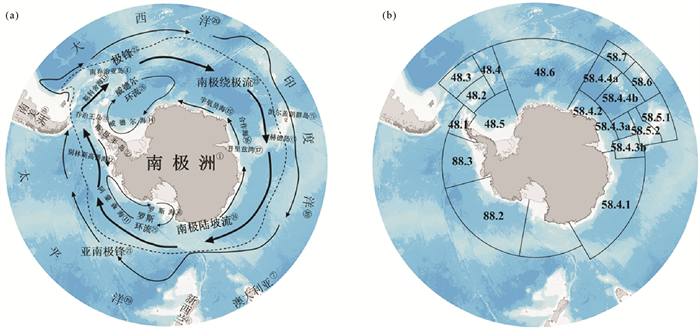
|
(①Antarctica; ②Antarctic Peninsula; ③King George Island; ④South Georgia Islands; ⑤Kerguelen Islands; ⑥Heard Island; ⑦Australia; ⑧New Zealand; ⑨South America; ⑩Ross Sea; ⑪ Amundsen Sea; ⑫ Bellingshausen Sea; ⑬ Scotia Sea; ⑭ Weddell Sea; ⑮ Cosmonaut Sea; ⑯ Cooperation Sea; ⑰ Prydz Bay; ⑱ Indian Ocean; ⑲ Pacific Ocean; ⑳ Atlantic Ocean; ㉑ Sub-Antarctic Front; ㉒ Polar Front; ㉓ Antarctic Circumpolar Current; ㉔ Antarctic Slope Current; ㉕ Ross Gyre; ㉖ Weddell Gyre.) 图 1 南大洋和南极主要环流(a)和渔业分区(亚区和小区)(b) Fig. 1 The Antarctica and the Southern Ocean showing major currents (a) and fishery areas(Subareas and Divisions) (b) |

|
(水层上部(红色箭头)和下部(蓝色箭头)环流,箭头表示平均流向;黑色小箭头示意内部热驱动混合(改自文献[10])。Upper (red arrows) and lower (blue arrows) circulation. Arrows indicate average flow direction. Interior heat-driven mixing is indicated by black small arrows (modified from[10]). SPZ: Subpolar zone; AZ: Antarctic zone; PFZ: Polar frontal zone; SAZ: Sub-antarctic zone; PF: Polar front; SAF: Sub-antarctic front; STF: Subtropical front; AASW: Antarctic surface water; SAMW: Sub-antarctic mode water; AAIW: Antarctic intermediate water; UCDW: Upper circumpolar deep water; LCDW: Lower circumpolar deep water; AABW: Antarctic bottom water.) 图 2 南大洋经向翻转流的简化示意图 Fig. 2 Simplified schematic view of the meridional overturning circulation of the Southern Ocean |
南大洋的环境在过去30年间发生了深刻的变化,其变化趋势和量级因区域而异。南极涛动(Antarctic oscillation, AAO)、厄尔尼诺与南方涛动(El Niño-southern oscillation, ENSO)、太平洋年代际振荡(Pacific Decadal Oscillation, PDO)和大西洋多年代际振荡(Atlantic Multidecadal Oscillation, AMO)等是调控南大洋环境,造成南极生物栖息地变化的主要气候模态[10-13]。其中AAO又称南极环状模(Southern annular mode, SAM),是南半球大气环流的主导模态和南大洋气候变化的主要驱动因素之一,表现为南半球副热带地区和高纬地区气压场呈现反位相变化振荡。AAO显示显著的年际变化特征,过去几十年显著增强(见图 3(a)),引起绕极西风增强,海洋向大气释放更多潜热通量,大型冰架破裂,促使之前被海冰所覆盖的栖息地中的浮游植物大量繁殖[14-16]。同时,西风加强可能使ACC南移,并改变相应锋面位置[17]。在全球尺度气候变化特别是大气环流的影响下,南大洋整体展现出海水淡化、海冰面积和年持续时长变化、西风变强、西风轴和极锋南移以及涡流强化等趋势[18-21]。年度范围内,富有季节性的多变物理特性是南大洋生态系统变化的驱动者,同时由于栖息地自身特征以及海冰特性显示出区域差异。
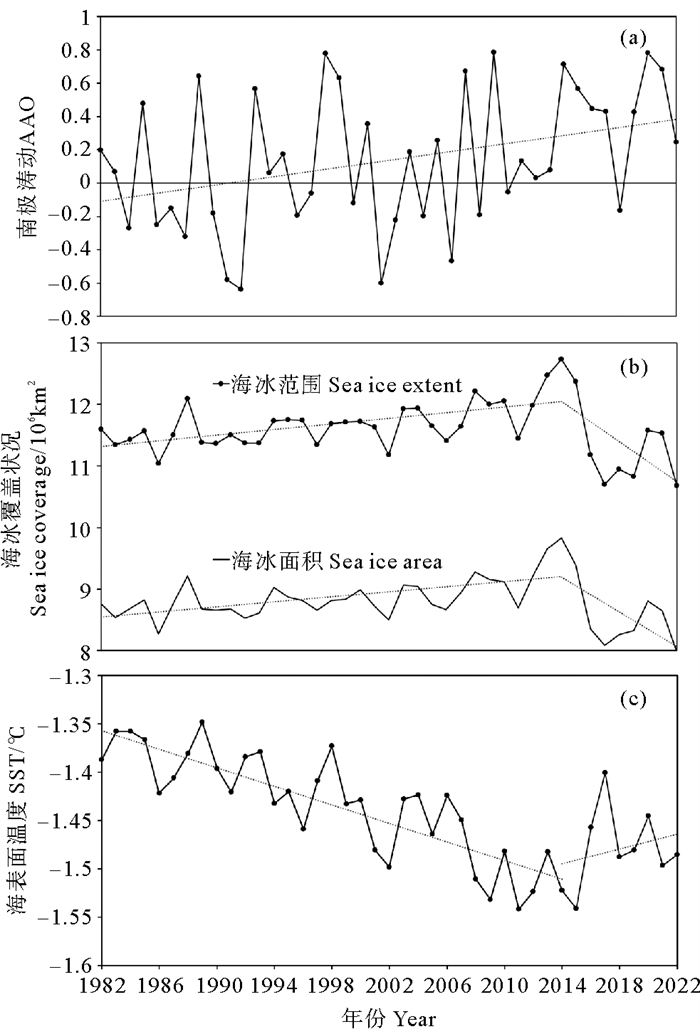
|
(数据分别源自美国气候预测中心(CPC,https://www.cpc.ncep.noaa.gov/products/precip/CWlink/daily_ao_index/aao/aao.shtml), 美国国家冰雪数据中心(NSIDC,https://nsidc.org/data/seaice_index)和美国国家环境信息中心(NCEI,https://psl.noaa.gov/data/gridded/data.noaa.oisst.v2.html)。(a): 南极涛动; (b): 海冰覆盖状况(海冰范围: 海冰密集度>15%的栅格(25 km×25 km)面积之和; 海冰面积: 海冰密集度>15%的栅格(25 km×25 km)面积与该栅格海冰密集度的乘积和); (c): 海表面温度。Data source: Climate Prediction Center(CPC, https://www.cpc.ncep.noaa.gov/products/precip/CWlink/daily_ao_index/aao/aao.shtml), National Snow and Ice Data Center(NSIDC, https://nsidc.org/data/seaice_index), and National Centers for Environmental Information(NCEI, https://psl.noaa.gov/data/gridded/data.noaa.oisst.v2.html). (a): Antarctic Oscillation; (b): Sea ice extent (adding up all the grid cells (25 km×25 km) with 15 percent sea ice concentration or more) and area (multiplying the area covered by each grid cell by the percentage of sea ice it contains, provided it has at least 15 percent concentration); (c): Sea surface temperature.) 图 3 1982—2022年南极环境气候因子的年平均值线性变化趋势 Fig. 3 Linear trends in Antarctic climate and environmental factors from 1982 to 2022 annual average |
海冰是南大洋的重要组成部分,通过热辐射和反射等方式影响海气热交换,其消长和随之带来的有机生产驱动着南大洋碳吸收过程,也影响海水温盐性质以及海流和水团动态。在冬季,它构成南极磷虾、企鹅等多种生物的栖息地,使这些生物在冰上、冰的周围栖息繁衍,并提供食物资源和避难所。春夏季节,海冰融化会释放铁和其他营养物质,充足的日光和营养盐使初级生产力大增,浮游植物繁盛。这种明显的季节变化通过食物网向上传播,以硅藻等为食的磷虾和幼鱼利用短暂的夏季进行繁殖或积累能量,以在低生产力的冬季生存[22-23]。南大洋冰山和浮冰的漂移模式也强烈影响着与海冰相关的物种分布,并能影响这些物种的生殖周期、补充和索饵行为[24]。因此,海冰被世界气象组织(World Meteorological Organization, WMO)划定为描述全球气候变化的7个主要指标之一[25],其厚度和范围的年际变化以及每年海冰出现时间和持续时长的波动格局是整个生态系统变化的重要驱动因素[26]。总的来说,西南极海冰密集度高于东南极,并存在大幅度的季节性变化,2月份(夏季)海冰只覆盖2×106~4×106 km2,而冬季的海冰范围则达到18×106~20×106 km2[27]。虽然全球气候变暖趋势显著,但是自20世纪70年代开始使用的卫星观测结果显示,直至2015年,南极海冰的总体范围和面积有所增加。与之对应,极圈以南整体海表面温度(Sea surface temperature, SST)也未表现出显著增暖趋势,温度变化缓慢甚至有所下降,该现象被称为“增暖迟滞”[28](见图 3(b), 3(c))。海冰和SST的变化展现出了较为稳定的区域性差异:罗斯海、威德尔海和印度洋扇区的海冰增多,SST下降,南极半岛、别林斯高晋海和阿蒙森海区域则相反[16, 29-32],其冰架融化受CDW入侵的影响很大(见图 4)。2016年,西南极海冰的减少已经超过了罗斯海海冰增加的程度,近年来南极海冰的总面积有所下降[33-35],SST也相应升高(见图 3(b), 3(c)),2022年海冰范围达到有卫星观测纪录以来的最小值,未来可能会继续减少[36-37]。和表层水不同,海水中下层温度变化一直与全球变暖趋势一致,深层增暖幅度甚至超过了全球平均的暖化速度。相对温暖的CDW向陆架入侵是阿蒙森海冰架融化的主要原因[38-39]。这种变暖主要集中在ACC中[21]。作为世界上最大最强的海流,通过连接海洋盆地,ACC使水团和不同的气候在海盆之间传播。由于ACC与地形的相互作用,在有上升流或混合水层的地区,初级生产力更高[40]。更深的混合层将更多营养物质带到海表面,但也使浮游植物在光合作用效果最好的浅水中的时间变少。气候变化模拟实验的预测表明海洋上层的密度分层将会增加,从而来自深海的养分供应减少[41]。伴随着平均辐照水平的增强,表面混合层会变浅。这些海洋上层变化的联合结果的模型预测(至2100年)表明,在亚南极水域和ACC南部,净初级生产率将增加,在其他水域则减少[42]。
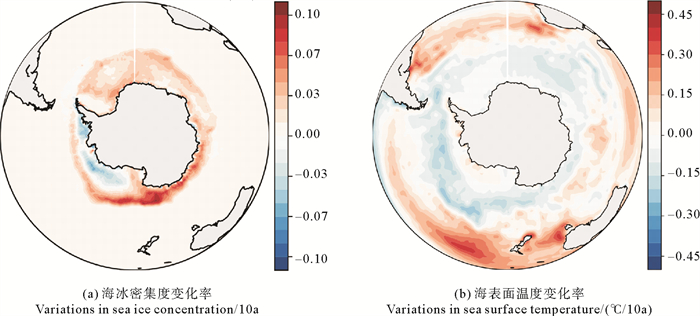
|
(数据来源同图 3(c)。Data source: the same as Fig. 3(c).) 图 4 1982—2022年南半球海冰密集度(a)和海表面温度(b)的变化趋势 Fig. 4 Trends of sea ice concentration (a) and sea surface temperature (b) in the Southern Hemisphere from 1982 to 2022 |
人类对南极生物资源的捕捞利用最早始于鳍脚类,随着开发技术的进步,范围逐渐扩大到鲸类、磷虾和鱼类生物。当前,出于种群保护目的,已经禁止对南极海洋哺乳类的开发,仅保留南极磷虾和底层鱼类产业。据此,同时按照营养级由低到高的顺序,此处首先介绍磷虾和鱼类的渔业情况,然后介绍鳍脚类和鲸类的开发历史和资源状况。
2.1 磷虾磷虾在南极生态系统尤其高纬度食物网中占据中心地位,也是该海域重要的捕捞对象。南极的磷虾通常指南极大磷虾Antarctic krill(Euphausia superba),该物种呈不均匀环极分布,寿命5~7龄,总生物量约为10亿t,是地球上生物量最大的物种之一,也是南极能量和物质流动的关键环节[43]。南极磷虾是南大洋生态系统中初级生产的主要消费者[44],同时又是企鹅、海豹、海鸟、鲸类、鱼类、头足类等生物的主要食物来源。作为沟通南极底层和高层营养级的关键种,磷虾在南大洋生态系统中建立了短而高效的食物网链接,直接在初级消费者和顶级捕食者之间建立联系,其种群结构的变化影响着南大洋食物网结构和生态系统功能[45]。
磷虾营养成分丰富,近来也被用于药品、保健品和化妆品制造中,具有广阔的生物开发前景,渔业资源价值巨大[46]。自1962年度(按CCAMLR渔季计,每个年度从前一年12月始至当年11月止)前苏联在南极试捕磷虾以来,日本、波兰、智利等国家相继开展磷虾的开发利用,其产量逐年上升,至1982年达到历史最高产量52.8万t。1986—1991年每年捕捞量维持在35万~40万t,其中90%的产量来源于前苏联。前苏联解体后,磷虾渔业产量骤减。近几年随着挪威等渔业国家的加入,南极磷虾的年捕捞量又呈稳定上升的趋势,近几年捕捞量维持在每年40万t左右(见图 5(a))[47-48],是当前南极渔业产量的主要提供者。中国于2007年加入CCAMLR,经过多次考察后,于2010年度正式开始对南极磷虾的商业性捕捞,2016年度捕捞量达到6万t,此后除2020年度捕捞量达到12万t外,其余年度年产量约为4万t(见图 5(b))[47, 49]。2013年起,日本退出对磷虾的捕捞,此后捕捞国家固定为挪威、智利、乌克兰、韩国和中国5个国家,其中挪威产量最高,约占总捕捞量的63%,其次是中国和韩国,分别占17%和14%。
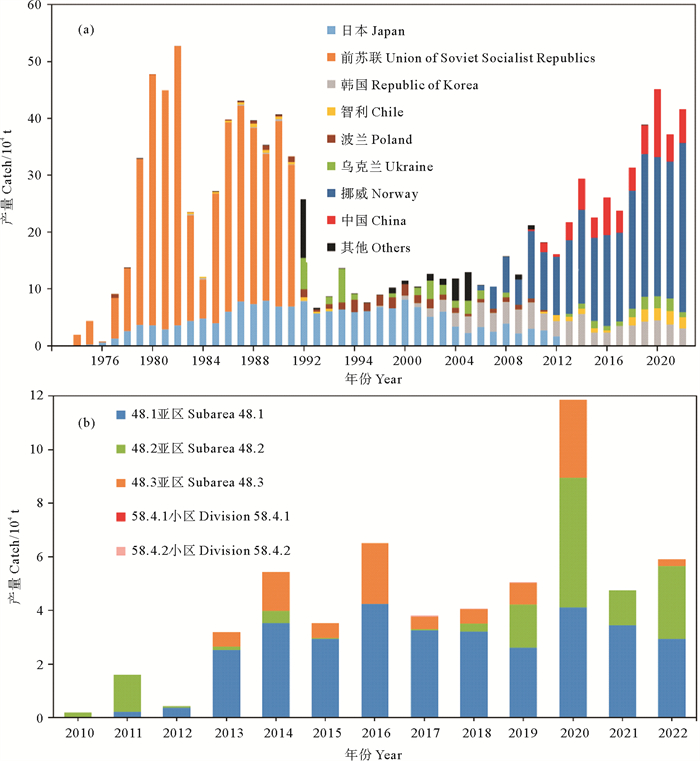
|
(数据源自南极海洋生物资源养护委员会(CCAMLR, https://www.ccamlr.org/en/publications/statistical-bulletin), 图 6—11和表 1同。(a): 主要入渔国家; (b): 中国。Data source: Commission for the Conservation of Antarctic Marine Living Resources(CCAMLR, https://www.ccamlr.org/en/publications/statistical-bulletin), also for Fig. 6—11 and table 1. (a): Main fishing countries; (b): China.) 图 5 南极磷虾渔业产量的年度统计 Fig. 5 Annual capture production of Antarctic krill |
1982年起,CCAMLR对南极辐合带以南的渔业活动进行管理[48]。磷虾密度分布最大的区域在南大西洋扇区,为了便于渔业管理,CCAMLR将联合国粮食及农业组织(Food and Agriculture Organization of the United Nations,FAO)划分的渔区划分为数个亚区和小区(见图 1(b)),在2003年将48.1—48.4亚区细分为更小规模的管理单元(Small-scale Management Units, SSMUs)。考虑到南极生态系统的脆弱性,为避免对南极磷虾资源的过度开发利用,CCAMLR对南极磷虾渔业的管理较为谨慎,当前设置年触发阈值产量为62万t。同时CCAMLR会定期实施科学调查以估算南极磷虾的资源量,根据资源评估的结果制定相应的捕捞限额和管理措施,并构建种群模型评估不同水平捕捞强度的影响。磷虾生物量的估算方法也不断发展,从浮游生物干重法、生产量与生物量比例系数转换法到网具采样法以及现行的声学法[50],但由于南极磷虾具有负生长等特性和环境条件的复杂性,对其生物量的评估仍具有一定难度[51]。
南极磷虾的捕捞通常采用中层拖网、桁拖网和水下连续泵吸的作业方式,其中泵吸式生产效率高,但目前只有挪威的两艘渔船使用[52]。作业深度一般为200 m,向下能够达到600 m。2013—2022年,48.1亚区的年捕捞量稳定在15万t左右,接近其限额;48.2亚区产量持续增加,近几年已和48.1亚区持平,48.3亚区呈不规则变化趋势,48.4亚区无磷虾渔船作业(见图 6)。虽然2017—2019年磷虾渔业的作业区域拓展到了58区,此后3年的渔业作业仍仅在48区进行。磷虾渔场和渔期受海冰情况和航线成本的制约并随季节变化,近3年作业在渔业初期都集中在48.2亚区的陆坡区,捕捞量首先随时间呈上升趋势,在南半球秋季达到最高,同时渔区向南乔治亚岛近海的48.1亚区转移,冬春季节渔场迁回至48.2和48.3亚区,同时捕捞量迅速下降(见图 7)。
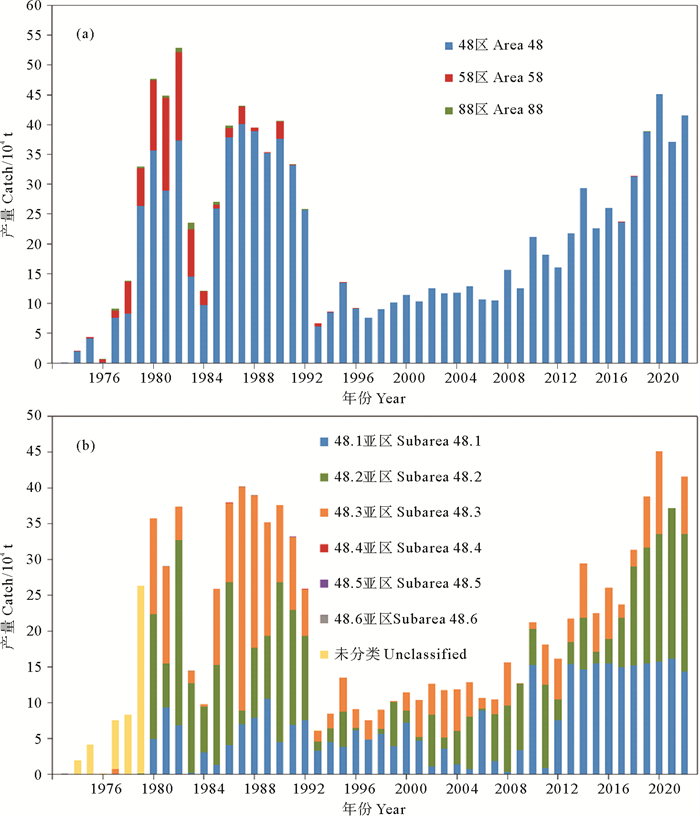
|
((a):各区;(b):48区各亚区。(a): Each Area; (b): Subareas in Area 48.) 图 6 不同区域南极磷虾渔业年产量图 Fig. 6 Annual catch of Antarctic krill fisheries by area |
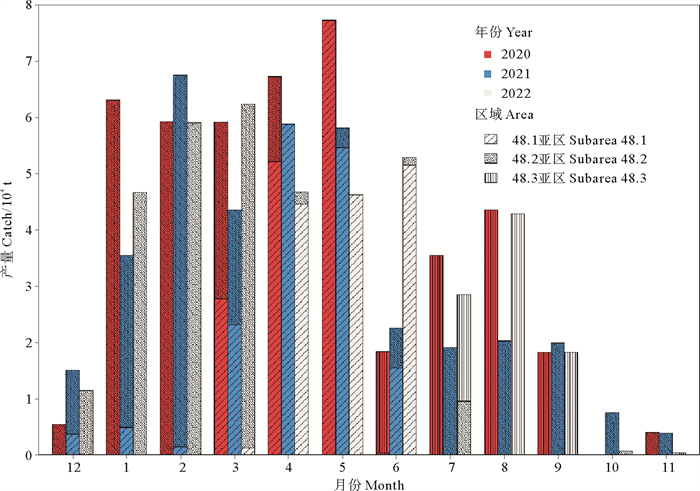
|
图 7 2020—2022年度48区南极磷虾月份产量图 Fig. 7 Monthly catch of Antarctic krill fisheries in Area 48 from 2020 to 2022 |
为了确保合理利用和保护南极磷虾生物资源,CCAMLR通常将能够导致南极磷虾资源大幅度变化的潜在因素控制在最小范围内。据研究,当前对磷虾触发阈值产量的指标要求并不会损害磷虾的资源状况,以中国主要作业区域48.1亚区为例,目前的触发阈值产量远远低于最大可持续产量(Maximum sustainable yield, MSY)的阈值[48],可以考虑适当提高捕捞限额,合理利用南极磷虾资源。
2.2 鱼类鱼类资源的开发是南极生物资源开发的重要一环。南大洋有超过374种鱼类,其中南极鱼亚目种类最丰富,共有8科129种[5, 53]。虽然和其他大洋相比种类有限,但是南大洋的鱼类具有重要的商业价值和科学研究意义。南极鱼类在南大洋食物网中占据中层到顶层营养级,部分鱼种在磷虾生物量波动时也作为替代饵料被鲸类等捕食[54]。南极鱼类中的很多鱼种体内具有抗冻糖蛋白(Antifreeze Glycoproteins, AFGPs),使其能够在冰冷的环境中生存[55]。不同鱼种还具有适应极端生境的独特能力,如鳄冰鱼科体内不含血红蛋白和肌红蛋白,通过其他方式增加对氧气的摄取量[56]。南极鱼类的独特基因库使其在医药、食品、农业等领域都表现出良好的应用前景。
由于南极地区独特的地理条件和环境,南极鱼类往往生长缓慢,生命周期长[57],一旦受到过度捕捞种群恢复也较慢[58]。以南大洋鱼类作为捕捞对象的渔业始于20世纪60年代末,初期主要捕捞对象为底栖鱼类。由于无限制的开发,20世纪80年代大鳞雅南极鱼(Lepidonotothen squamifrons)和作为主要兼捕对象的花纹南极鱼(Notothenia rossii)等资源遭到了极大破坏,渔业产量骤减[59],直至目前其资源状况仍不清楚[60](见图 8)。随着《南极海洋生物资源养护公约》于1982年生效,鱼类的开发开始在CCAMLR的渔业管理体系框架下进行,CCAMLR对各类渔业相继采取了限制和禁止措施。经过数次更替,目前南极海域中开展的商业性捕捞仅剩3种:裘氏鳄头冰鱼(Champsocephalus gunnari)、小鳞犬牙南极鱼(Dissostichus eleginoides)和鳞头犬牙南极鱼(D. mawsoni)。

|
图 8 1970—1999年大鳞雅南极鱼(a)和花纹南极鱼(b)渔业年产量图 Fig. 8 Annual catch of Lepidonotothen squamifrons (a) and Notothenia rossii (b) fisheries from 1970 to 1999 |
裘氏鳄头冰鱼属南极鱼亚目鳄冰鱼科,一般栖息于500 m以浅的陆架区域[61],多见于印度洋的凯尔盖朗群岛和赫德岛附近,以及大西洋的多数岛屿附近水域,即48和58渔区[62]。它体长能到60 cm,寿命12~14龄[63],主要以桡足类、介形类及磷虾为饵料[62],其丰度和分布与磷虾分布高度重合。20世纪70年代,裘氏鳄头冰鱼开始成为捕捞对象,其产量在1983年达到最高(20.7万t),但过度开发导致该产业在20世纪80年代末崩溃。1991年CCAMLR开始对冰鱼捕捞实行限额管理,此后该渔业波动频繁,2015年后年产量稳定在500 t左右(见图 9)。冰鱼的商业性渔业仅限在48.3亚区和58.5.2小区进行,48.3亚区的作业方式是浮拖网,在58.5.2小区采用中层拖网和底拖网。虽然48.3亚区规定的可捕量也很高,但是2015年后裘氏鳄头冰鱼的产量大部分来源于58区(见图 9,表 1)。
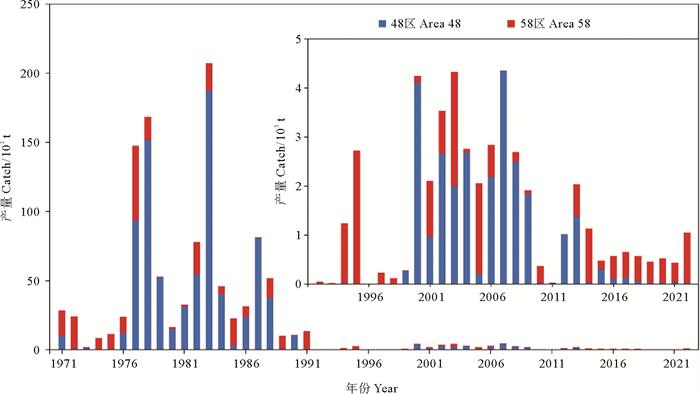
|
(小图显示1992年后产量状况。The smaller figure shows the fishing situation after 1992.) 图 9 裘氏鳄头冰鱼渔业年产量图 Fig. 9 Annual catch of Champsocephalus gunnari fisheries |
|
|
表 1 南大洋商业鱼种开发现状 Table 1 Current status of commercial fisheriesexploitation in the Southern Ocean |
小鳞犬牙南极鱼初期仅为拖网渔业的兼捕鱼种,到20世纪80年代中期随着延绳钓技术的发展成为南极渔业的主要捕捞对象之一,此后其产量持续稳定增加,未曾出现渔业资源崩溃的情况[59]。另一种经济价值也很高的南极犬牙鱼——鳞头犬牙南极鱼渔业始于20世纪末。这两种鱼同属南极鱼亚目南极鱼科,主要分布在南极辐合带以南水域,其中约80%分布在CCAMLR管辖海域内,其余多分布在澳大利亚、法国和南非的专属经济区(Exclusive economic zones, EEZs)等地[64],其渔业由CCAMLR和这几个国家共同管理(见表 1)。小鳞犬牙南极鱼最大体长达230 cm,体质量超过200 kg,寿命40~50龄。鳞头犬牙南极鱼又称莫氏犬牙南极鱼,由于血液中含有不冻糖肽(Peptide),抵御低温的能力更强,分布较小鳞犬牙南极鱼更南。该鱼种最大体长达175 cm,最重达80 kg,最大年龄可达40龄。两种南极犬牙鱼幼鱼均以浮游动物为食(主要为磷虾),成鱼主要捕食鱼类、头足类和甲壳类动物[64-66]。目前有15个渔区被允许在CCAMLR管辖下捕捞南极犬牙鱼,其中9个为探捕渔业。随着对鱼类资源状况的认识和开发利用活动的增加,渔业性质也不断变化,如在2019年,原本被定义为探捕性的48.4亚区的作业性质被转划成商业性。目前,小鳞犬牙南极鱼渔业被允许在48区和58区进行,主要集中在罗斯海和乔治王岛附近水域,年产量超过1万t。2011年来80%以上的渔获量都来源于58区,单位捕捞努力量渔获量(Catch per unit effort, CPUE)在各月间分布较为平均[67]。鳞头犬牙南极鱼作业在3个渔区内进行,年产量稳定在4 000 t左右,其中约80%由88区提供(见表 1, 图 10—11)。目前除58.5.2小区开展拖网作业外,其余渔区均采用延绳钓进行犬牙鱼渔业生产。
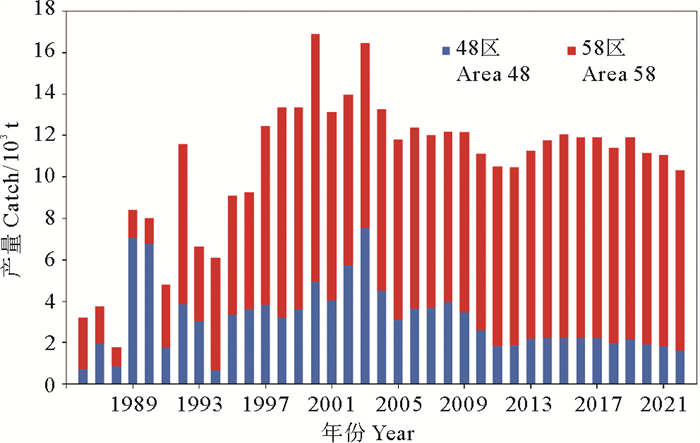
|
图 10 小鳞犬牙南极鱼渔业年产量图 Fig. 10 Annual catch of Dissostichus eleginoides fisheries |
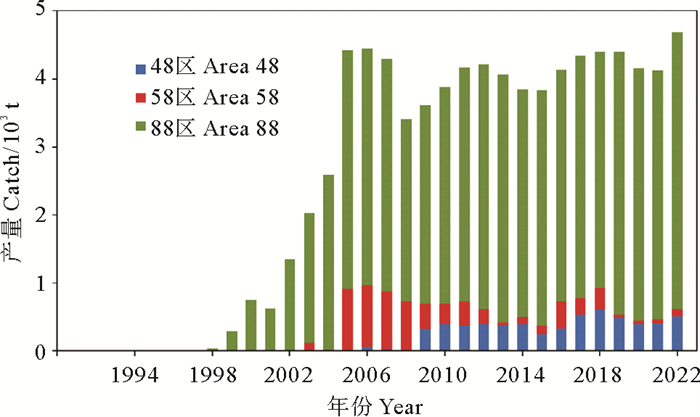
|
图 11 鳞头犬牙南极鱼渔业年产量图 Fig. 11 Annual catch of Dissostichus mawsoni fisheries |
底栖渔业之外,中上层鱼类也曾是南大洋商业捕捞的作业对象。南极鱼科的侧纹南极鱼(Pleuragramma antarcticum)是南极陆架生态系统中的关键物种,终身营浮游生活[68-69]。侧纹南极鱼主要摄食浮游生物,同时也是陆架区重要的饵料鱼种,是海鸟和哺乳动物的重要营养来源[70]。前苏联对它的捕捞从1978年持续到1984年,年捕获量峰值约为1150 t。其作业主要集中在58区,使用中层网板拖网。在离陆架较远的开放水域,中层鱼类具有更高的丰度[71-72]。南大洋的中层鱼类主要包括深海鲑科(Bathylagidae)、钻光鱼科(Gonostomatidae)、灯笼鱼科(Myctophidae)、大鳞蜥鱼科(Notosudidae)、魣蜥鱼科(Paralepididae)和巨口鱼科(Stomiidae)。它们通常栖息在200~1 000 m深水层,具有昼夜垂直迁移特性,且绝大多数物种会随生活史阶段发育向深海迁移。这些鱼种,尤其灯笼鱼科鱼类,在自上而下(top-down下行控制)和自下而上(bottom-up上行控制)的生态系统过程中发挥着重要“纽带”作用,并能够在磷虾生物量较小的地区和时期提供替代的能量流动路径[73-76]。中层鱼类生物量巨大,其中灯笼鱼科资源量可达到3亿t或更多[77-78],同时相较其他中层鱼能量含量更高,具有很高的营养价值[79]。过去针对该科鱼类(尤其次南极电灯鱼Electrona carlsbergi)的商业捕捞集中在1988—1993年,作业区域主要在48区,使用网板拖网和中层网板拖网进行作业,年捕获量最高约8万t。虽然目前不被纳入商业捕捞,较高的生物量和营养含量使这些中上层鱼类也具有一定的渔业开发潜力。
南极鱼类具有生长缓慢、寿命长等特性,如果其资源出现衰退,其种群恢复将十分缓慢,因此CCAMLR对公约区内的捕捞实行严格的汇报和管理制度,也开展了针对鱼类资源管理的科学研究工作,定期进行资源生物学和南极犬牙鱼标志重捕调查,并在数据较丰富的海区进行资源评估。目前在规划作业的渔区中,对部分区域的资源量已经具备初步认识,然而还有一些区域仍处于数据缺乏阶段,阻碍了对其资源的管理(见表 1)。今后,CCAMLR还应当进行更多的工作来支持对南极地区渔业的基础研究和资源评估,并在研究结果基础上合理设定商业鱼类可捕量,这将有助于更好地了解目标物种的资源状况及其对环境变化和捕捞作业的响应,同时有效地发挥这些资源的社会价值。
目前设定的可捕量基本都维持在资源量的10%以下,且除了48.3亚区,每个渔区的产量都接近其可捕量,可以考虑在进行资源量评估后增加一定的额度。同时现在目标鱼种仅有3种,而在实际作业中,其他一些鱼种也展现出一定的开发价值,例如独角冰鱼(Channichthys rhinoceratus)自2016年度年兼捕量均超过50 t,但并未针对性地对其进行开发。今后需要建立更稳健的调查机制,对潜在商业鱼种一并进行资源评估,从而能够更全面、更合理的开发和利用。
2.3 海洋哺乳类南极的海洋哺乳动物主要包括水陆两栖的鳍脚类和水生鲸豚类,它们在南极生态系统中担任顶级捕食者的角色,对当地生态系统结构和功能起到不可忽视的作用[80]。除了与其他物种的营养相互作用,鳍脚类在深层水的觅食以及鲸类的生物泵作用都能促进表层水与深层水的物质循环,对生物地球化学循环也有重要意义[81-83]。南极海洋物种登记册(Register of Antarctic marine species, RAMS)记录南极鳍脚类有11种,包括海狮科6种,海豹科5种;鲸类41种,其中须鲸亚目9种,齿鲸亚目32种。这些物种在食性上有很大的重叠,多数种类都对南极磷虾有很高需求[84],同时也以鱼类、头足类和甲壳类为食,更具攻击性的豹形海豹(Hydrurga leptonyx)和齿鲸类还会捕食企鹅和其他动物[85-88]。鲸脂(Blubber)在海洋哺乳动物中普遍存在,其具有维持体温、储存能量、调节浮力等作用[89],可用于炼油、化工、食品等,加之鳍脚类具有优质的毛皮,使海洋哺乳动物成为人类开发的优质对象[90]。
针对南极鳍脚类的大规模开发始于18世纪,主要对象是南极毛皮海狮(Arctocephalus gazella)和南象海豹(Mirounga leonina)[91]。1775年英美发现在南极(尤其南乔治亚岛区域)拥有丰富的南极毛皮海狮资源,随后派出大量船队对其进行捕杀,到19世纪初达到高峰,截至1822年该区域至少产出了120万张毛皮。随着南乔治亚岛的种群数量下降,该物种的其他聚集地被发现并被大量捕杀,到19世纪中叶,南极毛皮海狮种群崩溃,在1908年对南乔治亚岛的南极毛皮海狮进行最后一次商业捕捞之后,人们普遍认为该种接近灭绝[5, 92]。南极毛皮海狮种群崩溃后主要开发对象转向南象海豹,但由于南象海豹油脂的获取要消耗更多劳动力,且皮毛价值也不如南极毛皮海狮,开发强度相对较小,其种群衰退情况没有南极毛皮海狮严重[5]。为保护南极海豹资源,南极条约协商国在1972年起草并通过了《南极海豹保护公约》并于1978年正式生效。目前南极毛皮海狮种群已从危机中恢复,有学者认为其当前种群规模至少与开发前相似,但由于缺乏调查数据尚无法最终确定[93-94]。据估计目前南极毛皮海狮数量可能超过500万头[95],南象海豹数量也恢复至约65万头[96-97],均被国际自然保护联盟(International Union for Conservation of Nature, IUCN)红色物种名录评估为“无危”(Least concern)物种。
南半球捕鲸业开始于20世纪并迅速蔓延至南极海域。1904—1987年,南极地区的鲸类捕获数量超过115万头,捕获重量达6 500万t[5]。整个20世纪,全球近290万头大型鲸鱼被捕杀,其中南半球捕鲸数量是北半球的2.5倍[98]。南极长须鲸(Balaenoptera physalus quoyi)、抹香鲸(Physeter macrocephalus)和蓝鲸(B. musculus)的捕捞量占南半球捕捞总数的72.9%(见图 12)。蓝鲸的4个亚种之一,南极蓝鲸(B. musculus intermedia)体型巨大,鲸脂总量十分可观,是最早被大量捕捞的商业对象。1868—1978年全球共有382 595头蓝鲸被捕捞,其中南极蓝鲸就有345 775头,占比高达90.4%;1930年蓝鲸捕捞量达到顶峰(30 727头),其中98.8%为南极蓝鲸。开发前南极蓝鲸的种群数量约为20万~30万头,持续的捕鲸活动使其资源枯竭,至1973年仅占开发前水平的0.07%~0.29%[99]。由于蓝鲸种群在20世纪50年代数量严重下降,逐渐失去商业价值,捕鲸对象转向体型相对较小的南极长须鲸和抹香鲸,该产业维持了一段时间,但这些鲸类资源很快也被消耗殆尽[98]。
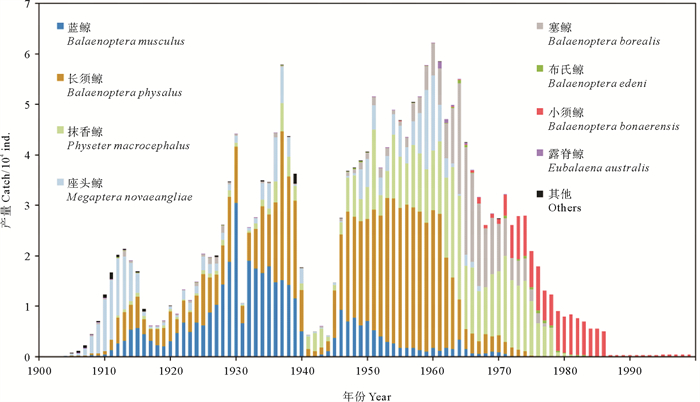
|
图 12 1900—1999年南半球商业捕鲸产量图(数据源自文献[98]) Fig. 12 Southern Hemisphere industrialized annual whaling catches from 1990 to 1999(data source: [98]) |
捕鲸业的发展导致鲸类数量的急剧下降,受到了各国重视,促成1946年《国际捕鲸管理公约》(ICRW)生效,其管理机构:国际捕鲸委员会(International Whaling Commission, IWC)也正式成立,但未能对捕鲸活动进行有效限制。鲸鱼的捕捞产量在两次世界大战期间有所下降,但随着战争结束,捕鲸量又重回高位,导致鲸类种群状况进一步恶化[100]。1982年,支持保护鲸类的国家在IWC占据了绝对多数,投票通过了对所有商业捕鲸的禁令,该禁令于1986年生效,随后捕鲸量得到一定控制。由于生长速度缓慢,南极长须鲸、抹香鲸和南极蓝鲸的种群数量估计仍不到开发前的一半[101-102]。目前,蓝鲸被IUCN红色物种名录评估为“濒危”(Endangered)物种,模型预测南半球蓝鲸数量为1 280头,IWC估计值为2 000头,均处于较低水平,且预计到2100年种群数量也仅能恢复至商业捕捞前的32%[101]。抹香鲸和长须鲸被IUCN红色物种名录评估为“易危”(Vulnerable)物种,但目前仍缺乏对其南半球种群状况的全面调查,因此IWC认为其整体种群丰度与数量变化趋势尚不清楚,但在一些种群已经观察到恢复态势[103],并观察到南极长须鲸返回南大洋的觅食地[104]。
全球海洋哺乳动物现存量只占到商业开发前生物量的1/5[105]。由开发转向保护之后,各国更加关注其生态旅游和文化方面的价值[106],许多以前衰退的海洋哺乳动物种群也正在恢复[107]。需要注意的是,鲸类保护与其他渔业活动之间的矛盾需要妥善解决[108]。鲸类动物的养护和管理工作目前由IWC负责,但该组织对磷虾和鱼类渔业的兼捕渔获物没有处置权,其和CCAMLR的共同管理流程还需进一步优化[109]。
由上可见,历史上大规模、无限制的开发对海洋哺乳类和鱼类的很多种群造成了极大破坏。对于鲸类和其他海洋哺乳类动物,至少在当前,以及未来很长一段时间内,IWC应该仍然会采取养护为主的管理策略。通过四十年的努力,南大洋磷虾和鱼类的渔业活动目前能够在CCAMLR及其渔业管理体系框架下有序进行,其发布的渔业管理制度和养护措施是预防和遏制IUU活动(非法Illegal、不报告Unreported和不受管制Unregulated捕捞)的有效手段。然而,由于生态学资料不足,现有政策也可能无法保证某些区域部分渔业的长期可持续性[54]。另外,如果未来扩大渔业对象范围,对新的商业目标种的管理预计也将与当前南极磷虾和鱼类渔业管理方式类似。为不重蹈20世纪70、80年代的覆辙,南极鱼类资源的利用应在科学的资源评估下进行,尤其要注意资源保护和生态系统健康。
3 南极生物资源对气候变化的响应人类活动是南大洋生物资源动态变化的主要驱动力,CCAMLR等组织通常通过资源评估结果确定磷虾和鱼类的可捕配额,但全球气候变化对评估渔业生物资源的未来情景提出了新的挑战。气候模型预测结果表明,南大洋未来海冰可能持续减少并进一步变暖,这可能会对海洋生物种群和当地生态系统产生负面影响[110-111]。南大洋的磷虾和鱼类特别适应南极洲周围水域的低温条件和海冰环境,容易受到气候驱动下环境变化的影响。由于高度依赖磷虾,鱼类和哺乳类的种群动态同时受南大洋理化环境和磷虾资源动态变化的制约,从而会使这些因素的作用进一步加剧。
3.1 磷虾南极磷虾的生活史同ACC密不可分,它在ACC中产卵孵化,也在ACC中衰老和死亡,海流和水团的分布对磷虾资源的分布具有明显的作用[112-113]。南极磷虾密度分布的最高区为南极半岛和斯科舍海陆架区域[114],纬度上在1 000 m等深线附近陆坡水域[115]。作为一种耐温范围狭窄的物种,气候变化导致的海水温度上升和锋面带南移[116]使磷虾的分布重心在过去90年整体向南移动和向陆架集中[117],而进一步的变暖可能会使这些栖息地未来更不利于磷虾的生存[118-119]。由于磷虾依靠海冰繁殖和生存,磷虾的饵料供应也都依赖于由海冰所驱动的环境因素[120],海冰范围等特征的变化会显著影响南极磷虾的丰度与补充,并改变其环极分布特征。南极众多环境因子如光照、海水温度、盐度、酸碱度的波动也都会影响磷虾的繁殖、生长、蜕壳等生活史过程和新陈代谢等生理特征[121-124],从而制约其丰度和补充[118, 125-127]。同时,AAO会通过影响磷虾的补充而影响南极磷虾的种群动态。伴随着AAO的减弱,磷虾的夏季补充减少。在过去几十年中,磷虾的补充量显著下降,下降幅度大于其密度的降幅[117]。然而,由于气候变化以及磷虾和环境协同作用的复杂性,目前该种群对环境变化的响应机制尚不完全清楚,再加上物候变化的区域性差异,南大洋磷虾种群总体资源状况的增减趋势仍不明晰[128-130]。
几十年来,磷虾种群的平均体长减小,但体质量有所增加[117]。过去的研究提供了一些区域性资源下降的证据,其中比较典型的是斯科舍海和南极半岛地区的磷虾群体由于海冰消退和迅速变暖个体大小和密度都减小,补充量和幼体存活率降低,分布垂向加深且向极移动[131-136],但并未发现南极磷虾整体资源的明确变化趋势。20世纪90年代,开始对南极一些水域进行监测调查,监测发现磷虾丰度或生物量指数表现出较高的年际间差异,但未查明方向性趋势[137-138]。模型结果显示南极半岛的磷虾群体同样符合这种高变异性但没有趋势的模式[139]。此外,磷虾有很多因地点和季节而异的替代适应性行为,这可能有助于抵御环境变化的影响[140]。在迅速变暖的环境下,南大西洋扇区的磷虾也可能将南印度洋和南太平洋水域作为其避难场所,导致当前磷虾在南大洋不同区域的数量比例有所改变[141]。特别是,磷虾等浮游动物对环境的响应可能是滞后的,环境发生极其迅速的变化后并不总是紧接着生物群的相应变化。南大西洋在过去80年间快速变暖,虽然物种分布模型预测生物的分布也会向极移动,但南极磷虾的分布在这一快速变暖时期较为稳定,在1995—2015年的变暖间歇期则突然向南跃迁[142]。
影响磷虾资源的主要生物因素是作为其饵料的浮游动植物。磷虾是植食性浮游动物,在食物匮乏时也表现出杂食性。南大洋冬春季节食物有限,水环境中的大型(>20 μm)浮游植物相比夏秋季节占比更少[143],该时期的摄食是磷虾补充和幼体生长的关键。海冰作为磷虾栖息地,能够为越冬磷虾提供良好的饵料环境。当春季来临时,冰下生长的浮游生物在浮冰融化后也能够在磷虾栖息的海洋表层大量繁殖生长。冬春季磷虾的摄食被发现会随海冰状况变动,近年来温暖的冰和更多的含盐水可能会使冰下的磷虾幼体更容易接近海冰生物群,表现出草食性,在寒冷时则更异养,同时依赖海冰生物群和水柱中的纤毛虫等[23]。食物来源的变化会改变南极磷虾自身的碳氮稳定同位素值,并影响以其为中心的南大洋食物网结构[144]。此外,死亡率对南极磷虾种群波动影响很大,南大洋的高营养级捕食者每年会消耗超过1亿t磷虾,气候变化和捕捞活动下捕食者的资源波动会通过下行效应对磷虾种群动态产生影响[145],比如未来须鲸种群的进一步恢复被预测会使磷虾种群生物量下降[3]。另外,海冰消退会使磷虾用于避敌的栖息地减小,被捕食概率增加,磷虾的垂直分布和集群程度也与其和捕食者的相互作用有关。
虽然磷虾的整体资源动态尚不明晰,但可能发生的区域性生物量下降会对当地食物网造成很大影响。在南极半岛附近观察到相继波动的“磷虾年”和“樽海鞘年”[146]。稳定同位素研究发现斯科舍海不同生物体内δ15N存在年际变动,由于磷虾的可用性降低,该海域的营养关系逐渐发生转变,中层鱼类和头足类捕食桡足类等浮游动物,并成为向顶级捕食者提供能量的主体[147]。这种更长、更低效的食物链会使能量流动过程产生更多能量逸散,并使污染物(如汞元素)在顶级捕食者体内更高浓度地富集[45, 148]。更重要的是,这些替代食物链可能无法支撑和磷虾同等水平的高营养级生物量[149-151],桡足类较慢的粪便颗粒下沉速度也使其从地表的生物地球化学循环中清除碳的速度下降[152]。这种替代的能流路径能够在多大程度上支持南大洋生态系统抵御未来气候变化引发的生物资源变化和其他一系列响应,将是未来需要重点关注的问题。
3.2 鱼类尽管南极鱼类的分布具有高度的地区特色,并存在着一些种群结构差异方面的证据[22, 153-156],大部分鱼类绕极分布且可能在整个南大洋具有相同的遗传学特征[157-159]。海洋环流的运动能够决定种群之间的连通程度并帮助维护鱼类种群。头带冰鱼(Chaenocephalus aceratus)和裘氏颚头冰鱼等冰鱼类的浮游性仔鱼期可以持续几个月,在发育过程中可能进行长距离输运[160]。南极半岛种群孵出的冰鱼仔鱼会在ACC中向东部和北部输运,补充到南奥克尼群岛种群中。鳞头犬牙南极鱼成鱼会随着区域环流沿大陆坡进入南太平洋洋脊产卵,浮游性的卵和仔鱼又被输运回罗斯海沿岸[161-162]。因此,未来洋流方向和速度的变化可能会影响鱼类的分布和输运,破坏洋流和鱼类相互作用的现状。
海冰和海水温度被认为是影响南极鱼类补充、丰度和分布的最重要环境因素。小鳞犬牙南极鱼幼鱼的丰度与成鱼在产卵前的海面温度成反比[68, 163]。全球变暖的环境下,南大洋海洋锋系统正在向南移动,不同鱼种表现出了不同的适应策略。多个地区的经济鱼种分布质心向极移动[112],鲨鱼、鳕鱼和灯笼鱼科等也会跟随着极锋迁移[73, 164]。由于适温范围极为狭窄,灯笼鱼极向迁移的幅度可能比其他鱼种更大[165]。同时该科鱼类被发现遵循伯格曼法则(Bergmann’s rule),海水持续增温后原本生活在低纬温暖水域中的较小个体会通过迁移取代高纬更大个体[166]。南极犬牙鱼可以进行远距离迁移并在广泛的深度范围内生存(从近岸到2 500 m以深),通过沉降或迁移来适应变暖[67, 167],但由于近岸分布的局限性,温度变化也可能会导致鳞头犬牙南极鱼孤立群体的灭绝[168]。冰鱼由于分布较为局限,并且因缺乏血红蛋白而依赖高氧化冷水,其更容易受到温度变化的影响[56]。深水上升流的增强可能会进一步促进这些深水物种向大陆架移动。海冰可能是侧纹南极鱼重要的产卵场,融冰状况、地表风和当地地理条件的相互作用会强烈影响侧纹南极鱼仔稚鱼的生长和存活,海冰的退缩也会增加该鱼种向更低温地区南移的概率[169-171]。
南极鱼类的生长、丰度和分布也受到饵料条件的影响。小鳞犬牙南极鱼幼鱼的生理生态会受海洋条件控制的饵料丰度的影响[172-173]。如果低营养级生物的分布因气候变化而改变,在产卵场和索饵场之间洄游的高营养级鱼类的饵料组成和洄游路线也会随之变化,如磷虾的极向迁移吸引了其捕食者向大陆架聚集[151]。南极绝大多数鱼种包括中层鱼类都高度依赖磷虾[174]。磷虾数量减少时冰鱼的生物量会受到负面影响,生长率也降低[175]。虽然侧纹南极鱼能够根据当地低营养级生物群落组成灵活地调整饵料,对南大洋不同区域侧纹南极鱼食性和生长的比较分析表明,南极半岛区域以磷虾为主要食物来源的个体生长状况最佳[150]。然而,南极鱼类的复杂生活史导致其摄食生态存在阶段性和区域性变化,以及和同营养级或更高营养级生物存在竞争关系[67, 176-178]。但与此相关的资料较少,局限在少数鱼种和有限区域。考虑到气候变化会引起南大洋理化条件发生复杂改变[179],仍需进一步探究其和低营养级资源波动共同作用下鱼类资源的变动机制和可能影响。
3.3 海洋哺乳类南极的海洋哺乳动物对气候变化的主要反应是分布范围的改变[180-181]。鲸类对气候变动高度敏感,每年都要在南半球高低纬度之间迁徙的座头鲸(Megaptera novaeangliae)在气候波动的年份会改变迁徙目的地,甚至完全跳过这一过程[182]。但也有证据表明鲸类能够通过改变栖息地利用模式和范围来适应这些变化,如座头鲸通常选择近岸浅海区域作为繁殖场所,如果气候变化使其繁殖成本上升,雌鲸将选择其他水域进行繁殖,并表现出对海底地形相对崎岖海域的偏好[183]。
海冰是影响海洋哺乳类的重要因素,如豹形海豹对海冰的依赖使其容易受到气候变化的影响,历史上南极海冰的增加推动了豹形海豹种群数量的增长[184]。麦夸里岛的南象海豹数量下降同样与海冰变化有关,但尚未明确其将如何影响海豹个体进而波及种群资源动态[185]。此外,冰间湖区域拥有较高的初级生产力,能够为南极的高营养级哺乳类提供重要食物来源。海豹在南极大陆的捕食活动有62%的时间集中在冰间湖区域,但气候变化预计将会导致冰间湖减少,这对捕食者将产生什么影响尚不清楚,需要进一步地观察和研究[186]。海冰密集度(Sea ice concentration, SIC)是解释南大洋须鲸类时空分布的重要环境因素之一。声学数据表明,随着SIC增加,南大洋中的须鲸会逐渐减少,座头鲸在SIC大于80%时很少出现[182, 187]。相反,南极小须鲸(Balaenoptera bonaerensis)常在有浮冰的海域进行活动,气候变暖导致的海冰范围下降会导致该物种适宜栖息地减少。对宇航员海栖息地的预测表明,如果不加以控制,南极小须鲸在该地的栖息地到21世纪末将完全丧失[188]。
气候变化能够影响磷虾、鱼类等重要饵料生物,从而对顶级捕食者产生间接影响,特别是作为南极高营养级生物最重要饵料的磷虾,其受气候制约的补充和区域连通性等特征会对顶级捕食者产生重要的上行控制效应[189-190]。豹形海豹等四种海豹依赖海冰捕食(统称为浮水海豹),其分布特征与其主要饵料的分布和相对丰度大致相同[191],变暖导致的南极半岛西部海冰减少改变了当地豹形海豹的夏季觅食模式。食蟹海豹(Lobodon carcinophagus)是豹形海豹在夏季的重要饵料,其在南极半岛西部的栖息地由于海冰减少而缩小,导致食蟹海豹的数量下降,使得豹形海豹的主要捕食对象由食蟹海豹的幼崽逐渐转为南极毛皮海狮幼崽[192]。气候变化导致的海冰流失不仅减少了浮冰海豹的适宜繁殖场所和栖息地[193],也通过影响南极磷虾的分布和数量而间接影响到该物种[194]。对南象海豹的研究也表明环境的影响主要是通过改变食物可获得性而改变种群数量[195]。有预测表明,随着环流、水温和海冰分布的变化,未来的海豹觅食栖息地将随着磷虾的分布向极扩展[196]。南极蓝鲸、座头鲸和南极小须鲸在捕食时偏好分布深度较浅、密度较高的磷虾群[197],气候变化如ENSO和AAO也会通过影响南极磷虾的可获得性而影响座头鲸的时空分布[182]。当食物可获得性下降、无法获取充足能量时,座头鲸会减少发声[187],同时雌鲸因无法积累繁殖和哺乳所需的能量而使妊娠率下降[198]。由于饵料的限制,当前座头鲸的数量可能已经处于种群增长和恢复的阈值,气候变化和海冰动态也已经导致一些依赖海冰和磷虾生存的海洋捕食者数量下降[191],今后需要更加谨慎地评估气候变化和人类活动对鲸类以及其他磷虾捕食者带来的影响[199]。
南极的顶级捕食者大都经历过大规模开发。曾被高度开发的南极鳍脚类现已消除了种群枯竭的威胁,如当前南象海豹的四个群体中,南乔治亚岛、瓦尔德斯半岛、凯尔盖朗群岛种群均相对稳定或缓慢增长,仅麦夸里岛群体数量呈缓慢下降状态[200]。然而过度庞大的数量也会给栖息地的环境造成负担,如南极毛皮海狮被认为对植被尤其是苔藓植物破坏严重[201-202]。此外,在气候变化对种群分布和饵料可获得性造成显著影响的背景下,顶级捕食者之间的相互作用效应也逐渐凸显。在南乔治亚岛区域,磷虾渔业、磷虾分布的向极、向海洋深处移动、以及当地座头鲸、海豹、海狮、企鹅等生物对磷虾的直接竞争等因素都随气候变化对海洋生态系统造成不可忽视的影响[203-204]。南大洋顶级捕食者对饵料的需求量不尽相同,尤以鲸类为多,因此当鲸类的种群逐渐恢复,并在南半球夏季迁徙到南大洋尤其南极半岛附近海域捕食磷虾时,会迫使其他捕食者扩大觅食范围,将更多的生物纳入食谱[205],同时增加觅食活动的能量投入[206]。
南极海洋哺乳类在气候变化下不同的适应性手段,以及栖息地海冰的高变异性,这些都对预测气候变化下种群动态发展带来挑战[185]。浮冰海豹栖息于浮冰上,难以使用传统的栖息地调查方式收集数据,需要结合电子标签、卫星图像等技术获得关于其时空分布和种群数量的数据。由于不能确定浮冰海豹对海冰和磷虾丰度变化的具体响应机制,模型预测结果也往往具有高度不确定性[194]。尽管因种而异,模型预测气候变化对鲸类的影响总是负面的,并且在有限数据的条件下需要考虑更多因素以降低不确定性,包括低纬度繁殖区域的变暖对幼崽存活率的影响、栖息范围的变化是否能减少迁徙期间的能量消耗等[207]。
人类活动直接作用于生物种群本身。捕捞行为会减少目标种群数量,改变或破坏其种群结构,从而影响群落结构和生态系统的平衡稳定。气候变化是南极生物普遍面临的威胁,气候通过影响海洋环境参数,如温度、盐度、海洋环流和海冰等影响南极生物种群的生长速率、繁殖周期和栖息地,往往由于上述参数的共同变异导致原有生境的适宜性下降,迫使生物种群改变其生理特性或分布范围,并产生新的营养关系[122-125]。总之,气候变化和人类活动的共同作用加剧了南极生态系统的脆弱性,使南极生物资源面临更大的生存压力,并且可能引发严重的生态后果[181]。在此背景下南极渔业资源的开发利用须更谨慎,综合考虑南极生态系统对气候变化和人类活动适应的敏感性,对于制定有效的南极生物资源管理和保护策略至关重要[208]。
4 总结与展望生态系统如何应对多种变化是指导南大洋渔业管理行动的重要问题[209-210]。需要采取预防性的生态系统方法进行管理,以促进枯竭种群的恢复,维护南大洋生态系统功能和相关产业。近几十年来,南极渔业资源的研究热度不断上升[211-212],人们积累了一些基本认识。然而,迄今为止,尚未确定何种方法能够最有效评估南极渔业生物资源量及其变动趋势,相关工作的结果也并不一致。南极生物资源的可持续性管理需要掌握其种群资源数量、分布、生活史特征、资源波动机制以及当地食物网结构和变化等多方面信息。捕捞压力、气候变化以及污染等相关的区域性和全球性驱动因素更是有可能产生协同效应和综合影响,这进一步加剧了南极生物面临的挑战。
为了减少人类捕捞对海洋哺乳类和鱼类等生物资源的破坏,人们成立了CCAMLR并开始构建南极海洋保护区(Antarctic Marine Protected Areas, AMPAs)。罗斯海海洋保护区建立之后,对其他AMPAs的构建提案也在不断推进[210, 213]。设立科学合理的海洋保护区能够维护海洋生物多样性和生态系统功能,有助于保护当地关键物种的栖息地和重要生态过程[213]。基于此,有学者期望建立更多、面积更大、时间更长的AMPA,然而现有的支撑数据仍显不足[214]。AMPA的有效性依赖被保护目标生物的分布和活动范围,由于不同物种具备不同的生活史、环境依赖关系和适应性特征,尚不明确它们会如何应对未来变化,有必要针对重要的资源种群持续开展基础性研究,增强对其关键生活史过程、资源波动和分布机制的了解,并基于多种方法进行定期资源评估,为南极渔业资源保护和管理决策提供信息[215-216]。此外,对这些生物资源的保护和管理应当在生态系统的大框架下进行,特别是需要确定关键种的变化会在多大程度上影响整个南极海洋生态系统[217]。也要考虑其他组分如渔业生物之外物种的生活史参数、群落结构、资源状况等信息,最终确定当地生态系统对气候变化和人类活动的响应机制,制定基于生态系统的南极渔业资源可持续利用策略。
尤其是,相对于南极磷虾和南极犬牙鱼等经济鱼种,关于南极中层鱼类生活史和种群动态的研究较为匮乏。这限制了对南大洋生态系统结构和动态的综合理解,现有的海洋保护区划定也往往没有充分考虑这些非经济鱼种的作用和功能[218]。侧纹南极鱼等几种鱼类的早期生活史研究为确定产卵场等关键栖息地提供了最新的证据[219-221]。目前,我国对南极渔业资源的开发主要是南极磷虾,受科研条件的限制,研究也主要基于渔业CPUE,但由于受到渔具和作业环境的限制,产量数据并不能完全反映资源状况。应当进一步开展南极科学综合考察,除传统生物学调查之外还需要结合其他新兴技术手段如环境DNA、声学监测、潜标等,通过多学科的观测调查方法,监测关键物种资源动态,摸清生态系统结构和特征,构建基于生态系统方法评估气候变化和人类捕捞的影响,提出南极渔业资源的可持续利用方案,强化和拓展我国在南极的海洋权益和话语权。
| [1] |
Caccavo J A, Christiansen H, Constable A J, et al. Productivity and change in fish and squid in the Southern Ocean[J]. Frontiers in Ecology and the Evolution, 2021, 9: 624918. DOI:10.3389/fevo.2021.624918 (  0) 0) |
| [2] |
CCAMLR. Resolution 30 about climate change[Z]. Hobart: Proceedings of the Summary of Conservation Measures and Resolutions in Force, 2009.
(  0) 0) |
| [3] |
Trebilco R, Melbourne-Thomas J, Constable A J. The policy relevance of Southern Ocean food web structure: Implications of food web change for fisheries, conservation and carbon sequestration[J]. Marine Policy, 2020, 115: 103832. DOI:10.1016/j.marpol.2020.103832 (  0) 0) |
| [4] |
Trathan P N, Reid K. Exploitation of the marine ecosystem in the sub-Antarctic: Historical impacts and current consequences[J]. Papers and Proceedings of the Royal Society of Tasmania, 2009, 143: 9-14. DOI:10.26749/rstpp.143.1.9 (  0) 0) |
| [5] |
Kock K H. Antarctic Fish and Fisheries[M]. Cambridge: Cambridge University Press, 1992.
(  0) 0) |
| [6] |
Martin J H, Fitzwater S E, Gordon R M. Iron deficiency limits phytoplankton growth in Antarctic waters[J]. Global Biogeochemical Cycles, 1990, 4(1): 5-12. DOI:10.1029/GB004i001p00005 (  0) 0) |
| [7] |
Orsi A H, Smethie W M, Bullister J L. On the total input of Antarctic waters to the deep ocean: A preliminary estimate from chlorofluorocarbon measurements[J]. Journal of Geophysical Research: Oceans, 2002, 107(C8): 3122. (  0) 0) |
| [8] |
Grant S M, Constable A, Doust S, et al. Bioregionalisation of the Southern Ocean: Report of Experts Workshop[R]. Hobart: WWF-Australia and ACE CRC, 2007.
(  0) 0) |
| [9] |
Kaiser S, Brandão S N, Brix S, et al. Patterns, processes and vulnerability of Southern Ocean benthos: A decadal leap in knowledge and understanding[J]. Marine Biology, 2013, 160(9): 2295-2317. DOI:10.1007/s00227-013-2232-6 (  0) 0) |
| [10] |
Stark J S, Raymond T, Deppeler S L, et al. Antarctic seas[M]// World Seas: An Environmental Evaluation. London: Academic Press, 2019: 1-44.
(  0) 0) |
| [11] |
Kwok R, Comiso J C. Southern Ocean climate and sea ice anomalies associated with the southern oscillation[J]. Journal of Climate, 2002, 15(5): 487-501. DOI:10.1175/1520-0442(2002)015<0487:SOCASI>2.0.CO;2 (  0) 0) |
| [12] |
林爱兰, 谷德军, 郑彬, 等. 南海夏季风爆发与南大洋海温变化之间的联系[J]. 地球物理学报, 2013, 56(2): 383-391. Lin A L, Gu D J, Zheng B, et al. Relationship between South China Sea summer monsoon onset and Southern Ocean sea surface temperature variation[J]. Chinese Journal of Geophysics, 2013, 56(2): 383-391. (  0) 0) |
| [13] |
Turner J, Colwell S R, Marshall G J, et al. Antarctic climate change during the last 50 years[J]. International Journal of Climatology, 2005, 25(3): 279-294. DOI:10.1002/joc.1130 (  0) 0) |
| [14] |
Lenton A, Matear R J. Role of the Southern Annular mode (SAM) in Southern Ocean CO2 uptake[J]. Global Biogeochemical Cycles, 2007, 21(2): GB2016. DOI:10.1029/2006GB002714 (  0) 0) |
| [15] |
Sokolov S, Rintoul S R. Circumpolar structure and distribution of the Antarctic Circumpolar Current fronts: 1. Mean circumpolar paths[J]. Journal of Geophysical Research Oceans, 2009, 114: C11018. (  0) 0) |
| [16] |
Turner J, Barrand N E, Bracegirdle T J, et al. Antarctic climate change and the environment: An update[J]. Polar Record, 2013, 50(3): 237-259. (  0) 0) |
| [17] |
Downes S M, Budnick A S, Sarmiento J L, et al. Impacts of wind stress on the Antarctic Circumpolar Current fronts and associated subduction[J]. Geophysical Research Letters, 2011, 38: L11605. (  0) 0) |
| [18] |
Raphael M N, Marshall G J, Turner J, et al. The Amundsen Sea low: Variability, change, and impact on Antarctic climate[J]. Bulletin of the American Meteorological Society, 2016, 97(1): 111-121. DOI:10.1175/BAMS-D-14-00018.1 (  0) 0) |
| [19] |
Schneider D P, Deser C. Tropically driven and externally forced patterns of Antarctic sea ice change: Reconciling observed and modeled trends[J]. Climate Dynamics, 2017, 50(11-12): 4599-4618. (  0) 0) |
| [20] |
Hazel J E, Stewart A L. Are the near-Antarctic easterly winds weakening in response to enhancement of the southern annular mode[J]. Journal of Climate, 2019, 32: 1-27. (  0) 0) |
| [21] |
Gille S T. Decadal-scale temperature trends in the Southern Hemisphere ocean[J]. Journal of Climate, 2008, 21(18): 4749-4765. DOI:10.1175/2008JCLI2131.1 (  0) 0) |
| [22] |
Liggett D, Storey B, Cook Y, et al. Exploring the Last Continent[M]. Switzerland: Springer Cham, 2015.
(  0) 0) |
| [23] |
Jia Z, Swadling K M, Meiners K M, et al. The zooplankton food web under East Antarctic pack ice: A stable isotope study[J]. Deep Sea Research Part Ⅱ: Topical Studies in Oceanography, 2016, 131: 189-202. DOI:10.1016/j.dsr2.2015.10.010 (  0) 0) |
| [24] |
Thomas D N, Dieckmann G S. Sea Ice: An Introduction to Its Physics, Chemistry, Biology and Geology[M]. [S. l. ]: Blackwell Science Ltd, 2003.
(  0) 0) |
| [25] |
WMO. Global climate indicators[EB/OL]. (2023-6-25)[2024-6-11]. https://climatedata-catalogue-wmo.org/climate_indicators.
(  0) 0) |
| [26] |
Massoma R A, Stammerjohn S E. Antarctic sea ice change and variability-physical and ecological implications[J]. Polar Science, 2010, 4(2): 149-186. DOI:10.1016/j.polar.2010.05.001 (  0) 0) |
| [27] |
Comiso J C, Nishio F. Trends in the sea ice cover using enhanced and compatible AMSR-E, SSM/I, and SMMR data[J]. Journal of Geophysical Research: Oceans, 2008, 113: C02S07. (  0) 0) |
| [28] |
Armour K C, Marshall J, Scott J R, et al. Southern Ocean warming delayed by circumpolar upwelling and equatorward transport[J]. Nature Geoscience, 2016, 9(7): 549-554. DOI:10.1038/ngeo2731 (  0) 0) |
| [29] |
Liu J, Curry J A, Martinson D G. Interpretation of recent Antarctic sea ice variability[J]. Geophysical Research Letters, 2004, 31(2): L02205. (  0) 0) |
| [30] |
King J. A resolution of the Antarctic paradox[J]. Nature, 2014, 505: 491-492. DOI:10.1038/505491a (  0) 0) |
| [31] |
Parkinson C L. A 40-y record reveals gradual Antarctic sea ice increases followed by decreases at rates far exceeding the rates seen in the Arctic[J]. Proceedings of the National Academy of Sciences, 2019, 116(29): 14414-14423. DOI:10.1073/pnas.1906556116 (  0) 0) |
| [32] |
邓丽静, 王慧, 金波文, 等. 1979—2022年南极海冰范围变动特征及趋势分析[J]. 海洋通报, 2024, 43(5): 1-10. Deng L J, Wang H, Jin B W, et al. Analysis of the characteristics and trends of Antarctic sea ice extent changes from 1979 to 2022[J]. Marine Science Bulletin, 2024, 43(5): 1-10. (  0) 0) |
| [33] |
Turner J, Comiso J. Solve Antarctica's sea-ice puzzle[J]. Nature, 2017, 547: 275-277. DOI:10.1038/547275a (  0) 0) |
| [34] |
Raphael M N, Handcock M S. A new record minimum for Antarctic sea ice[J]. Nature Reviews Earth & Environment, 2022, 3(4): 215-216. (  0) 0) |
| [35] |
Wang G, Hendon H H, Arblaster J M, et al. Compounding tropical and stratospheric forcing of the record low Antarctic sea-ice in 2016[J]. Nature Communications, 2019, 10(13): 1-9. (  0) 0) |
| [36] |
Ludescher J, Yuan N, Bunde A. Detecting the statistical significance of the trends in the Antarctic sea ice extent: An indication for a turning point[J]. Climate Dynamics, 2018, 53(1-2): 237-244. (  0) 0) |
| [37] |
Montie S, Thomsen M S, Rack W, et al. Extreme summer marine heatwaves increase chlorophyll a in the Southern Ocean[J]. Antarctic Science, 2020, 32(6): 508-509. DOI:10.1017/S0954102020000401 (  0) 0) |
| [38] |
Jacobs S S, Hellmer H H, Jenkins A. Antarctic Ice Sheet melting in the southeast Pacific[J]. Geophysical Research Letters, 1996, 23(9): 957-960. DOI:10.1029/96GL00723 (  0) 0) |
| [39] |
Mallett H K W, Boehme L, Fedak M, et al. Variation in the distribution and properties of circumpolar deep water in the eastern Amundsen Sea, on seasonal timescales, using seal-borne tags[J]. Geophysical Research Letters, 2018, 45(10): 4982-4990. DOI:10.1029/2018GL077430 (  0) 0) |
| [40] |
Dayton P K, Mordida B J, Bacon F. Polar marine communities[J]. American Zoologist, 1994, 34(1): 90-99. DOI:10.1093/icb/34.1.90 (  0) 0) |
| [41] |
Boyd P W, Doney S C, Strzepek R, et al. Climate-mediated changes to mixed-layer properties in the Southern Ocean: Assessing the phytoplankton response[J]. Biogeosciences, 2008, 5: 847-864. DOI:10.5194/bg-5-847-2008 (  0) 0) |
| [42] |
Bopp L, Resplandy L, Orr J C, et al. Multiple stressors of ocean ecosystems in the 21st century: Projections with CMIP5 models[J]. Biogeosciences, 2013, 10(10): 6225-6245. DOI:10.5194/bg-10-6225-2013 (  0) 0) |
| [43] |
Li L, Lu P, Chi H, et al. Sustainable development of Antarctic krill environmental resources based on system dynamics[J]. Ecological Chemistry and Engineering S, 2021, 28(4): 471-485. DOI:10.2478/eces-2021-0031 (  0) 0) |
| [44] |
黄洪亮, 陈雪忠, 冯春雷. 南极磷虾资源开发现状分析[J]. 渔业现代化, 2007, 34(1): 48-51. Huang H L, Chen X Z, Feng C L. Status of Euphausia superba resource exploration[J]. Fishery Modernization, 2007, 34(1): 48-51. DOI:10.3969/j.issn.1007-9580.2007.01.017 (  0) 0) |
| [45] |
Murphy E J, Cavanagh R D, Hofmann E E, et al. Developing integrated models of Southern Ocean food webs: Including ecological complexity, accounting for uncertainty and the importance of scale[J]. Progress in Oceanography, 2012, 102: 74-92. DOI:10.1016/j.pocean.2012.03.006 (  0) 0) |
| [46] |
Nicol S, Foster J, Kawaguchi S. The fishery for Antarctic krill-recent developments[J]. Fish and Fisheries, 2011, 13(1): 30-40. (  0) 0) |
| [47] |
孙松, 刘永芹. 南极磷虾与南大洋生态系统[J]. 自然杂志, 2009, 31(2): 88-90, 104. Sun S, Liu Y Q. Antarctic krill and Southern Ocean ecosystem[J]. Chinese Journal of Nature, 2009, 31(2): 88-90, 104. DOI:10.3969/j.issn.0253-9608.2009.02.005 (  0) 0) |
| [48] |
杨嘉樑, 黄洪亮, 李九奇, 等. 基于贝叶斯方法的FAO48.1区南极磷虾渔业资源评估[J]. 中国农业科技导报, 2018, 20(10): 123-130. Yang J L, Huang H L, Li J Q, et al. Stock assessment of Antarctic krill in FAO 48.1 sub-area by Bayes-based pella-tomlinson model[J]. Journal of Agricultural Science and Technology, 2018, 20(10): 123-130. (  0) 0) |
| [49] |
黄洪亮, 陈雪忠, 刘健, 等. 南极磷虾渔业近况与趋势分析[J]. 极地研究, 2015, 27(1): 25-30. Huang H L, Chen X Z, Liu J, et al. Analysis of the status and trend of the Antarctic krill fishery[J]. Chinese Journal of Polar Research, 2015, 27(1): 25-30. (  0) 0) |
| [50] |
许柳雄, 王腾, 朱国平, 等. 南极磷虾生物量估算方法[J]. 水产学报, 2018, 42(2): 808-816. Xu L X, Wang T, Zhu G P, et al. Methods for biomass estimation of Antarctic krill (Euphausia superba): A review[J]. Journal of Fisheries of China, 2018, 42(2): 808-816. (  0) 0) |
| [51] |
朱国平, 王芮. 南极磷虾渔业CPUE及其丰度估算适用性[J]. 水产学报, 2016, 40(7): 1072-1079. Zhu G P, Wang R. Catch per unit effort of Antarctic krill (Euphausia superba) fishery and its suitability to abundance estimation[J]. Journal of Fisheries of China, 2016, 40(7): 1072-1079. (  0) 0) |
| [52] |
左涛, 朱建成, 王新良, 等. 南极磷虾渔业科学观察覆盖率管理策略和中国履约[J]. 极地研究, 2017, 29(1): 124-132. Zuo T, Zhu J C, Wang X L, et al. Management strategy of the observer coverage under the scheme of international scientific observation for Antarctic krill fishery and performance review of observation program in Chinese krill fishery[J]. Chinese Journal of Polar Research, 2017, 29(1): 124-132. (  0) 0) |
| [53] |
Duhamel G, Hulley P, Causse R, et al. Biogeographic patterns of fish[M]//Broyer C D, Koubbi P, Griffiths H, et al. Biogeographic Atlas of the Southern Ocean. Cambridge: Scientific Committee on Antarctic Research, 2014: 328-362.
(  0) 0) |
| [54] |
Pinkerton M H, Bradford-Grieve J M. Characterizing foodweb structure to identify potential ecosystem effects of fishing in the Ross Sea, Antarctica[J]. ICES Journal of Marine Science, 2014, 71(7): 1542-1553. (  0) 0) |
| [55] |
Near T J, Dornburg A, Kuhn K L, et al. Ancient climate change, antifreeze, and the evolutionary diversification of Antarctic fishes[J]. Proceedings of the National Academy of Sciences of the United States of America, 2012, 109(9): 3434-3439. (  0) 0) |
| [56] |
Sidell B D, O'Brien K M. When bad things happen to good fish: The loss of hemoglobin and myoglobin expression in Antarctic icefishes[J]. Journal of Experimental Biology, 2006, 209(10): 1791-1802. (  0) 0) |
| [57] |
朱国平, 魏联. 南极鱼类年龄与生长研究进展[J]. 水产学报, 2017, 41(10): 1638-1647. Zhu G P, Wei L. Age and growth of Antarctic fish species: A review[J]. Journal of Fisheries of China, 2017, 41(10): 1638-1647. (  0) 0) |
| [58] |
Hollyman P R, Hill S L, Laptikhovsky V V, et al. A long road to recovery: Dynamics and ecology of the marbled rockcod (Notothenia rossii, family: Nototheniidae) at South Georgia, 50 years after overexploitation[J]. ICES Journal of Marine Science, 2021, 78(8): 2745-2756. (  0) 0) |
| [59] |
朱国平. 南大洋有鳍鱼类渔业平均营养级的长期变动[J]. 生态学杂志, 2014, 33(6): 1573-1579. Zhu G P. Long-term changes in the mean trophic level of the finfish fishery in the Southern Ocean[J]. Chinese Journal of Ecology, 2014, 33(6): 1573-1579. (  0) 0) |
| [60] |
Barrera-Oro E, Marschoff E, Ainley D. Changing status of three notothenioid fish at the South Shetland Islands (1983—2016) after impacts of the 1970—80s commercial fishery[J]. Polar Biology, 2017, 40(10): 2047-2054. (  0) 0) |
| [61] |
Kock K H, Everson I. Biology and ecology of mackerel icefish, Champsocephalus gunnari: An Antarctic fish lacking hemoglobin[J]. Comparative Biochemistry and Physiology Part A: Physiology, 1997, 118(4): 1067-1077. (  0) 0) |
| [62] |
Kock K H, Everson I. Shedding new light on the life cycle of mackerel icefish in the Southern Ocean[J]. Journal of Fish Biology, 2003, 63(1): 1-21. (  0) 0) |
| [63] |
Everson I, Parkes G, Kock K H, et al. Variation in standing stock of the mackerel icefish Champsocephalus gunnari at South Georgia[J]. Journal of Applied Ecology, 2001, 36(4): 591-603. (  0) 0) |
| [64] |
虞宝存, 朱文斌, 陈峰, 等. 犬牙南极鱼类渔业资源利用现状[J]. 河北渔业, 2013(7): 12-14. Yu B C, Zhu W B, Chen F, et al. Current fishery resources utilization of Antarctic toothfish Dissostichus spp[J]. Hebei Fisheries, 2013(7): 12-14. (  0) 0) |
| [65] |
缪圣赐, 邱卫华, 周雨思, 等. 南极周边海域犬牙鱼资源及其渔业概况[J]. 渔业信息与战略, 2015, 30(1): 61-65. Liao S C, Qiu W H, Zhou Y S, et al. Toothfish resources and fishery in waters around the Antarctic[J]. Modern Fisheries Information, 2015, 30(1): 61-65. (  0) 0) |
| [66] |
Roberts J, Xavier J C, Agnew D J. The diet of toothfish species Dissostichus eleginoides and Dissostichus mawsoni with overlapping distributions[J]. Journal of Fish Biology, 2011, 79(1): 138-154. (  0) 0) |
| [67] |
朱国平. 南大洋小鳞犬牙南极鱼渔业时间变化及其对气候变化的响应[J]. 海洋环境科学, 2013, 32(5): 663-668. Zhu G P. The temporal variation on Patagonian toothfish (Dissostichus eleginoides) fishery in the Southern Ocean and its response to the climate change[J]. Marine Environmental Science, 2013, 32(5): 663-668. (  0) 0) |
| [68] |
La Mesa M, Eastman J T. Antarctic silverfish: Life strategies of a key species in the high-Antarctic ecosystem[J]. Fish and Fisheries, 2011, 13(3): 241-266. (  0) 0) |
| [69] |
Vacchi M, Pisano E, Ghigliotti L. The Antarctic Silverfish: A Keystone Species in a Changing Ecosystem[M]. Berlin: Springer, 2017.
(  0) 0) |
| [70] |
Giraldo C, Cherel Y, Vallet C, et al. Ontogenic changes in the feeding ecology of the early life stages of the Antarctic silverfish (Pleuragramma antarcticum) documented by stable isotopes and diet analysis in the Dumont d'Urville Sea (East Antarctica)[J]. Polar Science, 2011, 5(2): 252-263. (  0) 0) |
| [71] |
Van De Putte A P, Jackson G D, Pakhomov E, et al. Distribution of squid and fish in the pelagic zone of the Cosmonaut Sea and Prydz Bay region during the BROKE-West campaign[J]. Deep Sea Research Part Ⅱ: Topical Studies in Oceanography, 2010, 57(9-10): 956-967. (  0) 0) |
| [72] |
Collins M A, Stowasser G, Fielding S, et al. Latitudinal and bathymetric patterns in the distribution and abundance of mesopelagic fish in the Scotia Sea[J]. Deep Sea Research Part Ⅱ: Topical Studies in Oceanography, 2012, 59-60: 189-198. (  0) 0) |
| [73] |
Saunders R A, Hill S L, Tarling G A, et al. Myctophid fish (Family Myctophidae) are central consumers in the food web of the Scotia Sea (Southern Ocean)[J]. Frontiers in Marine Science, 2019, 6: 530. (  0) 0) |
| [74] |
Murphy E J, Watkins J L, Trathan P N, et al. Spatial and temporal operation of the Scotia Sea ecosystem: A review of large-scale links in a krill centred food web[J]. Philosophical Transactions of the Royal Society B: Biological Sciences, 2006, 362(1477): 113-148. (  0) 0) |
| [75] |
Murphy E J, Trathan P N, Watkins J L, et al. Climatically driven fluctuations in Southern Ocean ecosystems[J]. Proceedings of the Royal Society B: Biological Sciences, 2007, 274(1629): 3057-3067. (  0) 0) |
| [76] |
Mccormack S A, Melbourne-Thomas J, Trebilco R, et al. Decades of dietary data demonstrate regional food web structures in the Southern Ocean[J]. Ecology and Evolution, 2020, 11(1): 227-241. (  0) 0) |
| [77] |
Hulley P A. Results of the research cruises of FRV "Walther Herwig" to South America. 58. Family Myctophidae (Osteichthyes, Myctophiformes). [J]. Arch für Fischereiwissenschaft, 1981, 31: 1-300.
(  0) 0) |
| [78] |
Kaartvedt S, Staby A, Aksnes D L. Efficient trawl avoidance by mesopelagic fishes causes large underestimation of their biomass[J]. Marine Ecology Progress Series, 2012, 456: 1-6. (  0) 0) |
| [79] |
Van De Putte A, Flores H, Volckaert F, et al. Energy content of Antarctic mesopelagic fishes: Implications for the marine food web[J]. Polar Biology, 2006, 29(12): 1045-1051. (  0) 0) |
| [80] |
Bowen W D. Role of marine mammals in aquatic ecosystems[J]. Marine Ecology Progress Series, 1997, 158: 267-274. (  0) 0) |
| [81] |
Mcintyre T, Bornemann H, Plötz J, et al. Deep divers in even deeper seas: Habitat use of male southern elephant seals from Marion Island[J]. Antarctic Science, 2012, 24(6): 561-570. (  0) 0) |
| [82] |
Ratnarajah L, Bowie A R, Lannuzel D, et al. The biogeochemical role of baleen whales and krill in Southern Ocean nutrient cycling[J]. PLoS One, 2014, 9(12): e114067. (  0) 0) |
| [83] |
Roman J, Mccarthy J J. The whale pump: Marine mammals enhance primary productivity in a coastal basin[J]. PLoS One, 2010, 5(10): e13255. (  0) 0) |
| [84] |
Ainley D G, Lindke K, Ballard G, et al. Spatio-temporal occurrence patterns of cetaceans near Ross Island, Antarctica, 2002—2015: Implications for food web dynamics[J]. Polar Biology, 2017, 40: 1761-1775. (  0) 0) |
| [85] |
Casaux R, Baroni A, Ramón A, et al. Diet of the leopard seal Hydrurga leptonyx at the Danco Coast, Antarctic Peninsula[J]. Polar Biology, 2008, 32: 307-310. (  0) 0) |
| [86] |
Hückstädt L A, Burns J M, Koch P L, et al. Diet of a specialist in a changing environment: The crabeater seal along the western Antarctic Peninsula[J]. Marine Ecology Progress Series, 2012, 455: 287-301. (  0) 0) |
| [87] |
Daneri G A, Carlini A R, Marschoff E R, et al. The feeding habits of the Southern elephant seal, Mirounga leonina, at Isla 25 de Mayo/King George Island, South Shetland Islands[J]. Polar Biology, 2014, 38: 665-676. (  0) 0) |
| [88] |
Pitman R L, Ensor P. Three forms of killer whales (Orcinus orca) in Antarctic waters[J]. The Journal of Cetacean Research and Management, 2003, 5(2): 131-139. (  0) 0) |
| [89] |
Liwanag H E M, Berta A, Costa D P, et al. Morphological and thermal properties of mammalian insulation: The evolutionary transition to blubber in pinnipeds[J]. Biological Journal of the Linnean Society, 2012, 107(4): 774-787. (  0) 0) |
| [90] |
陈万青, 郑长禄, 张起信. 海洋哺乳动物[M]. 青岛: 青岛海洋大学出版社, 1992. Chen W Q, Zheng C L, Zhang Q X. Marine Mammals[M]. Qingdao: Qingdao Ocean University Press, 1992. (  0) 0) |
| [91] |
Berta A, Sumich J L, Kovacs K M. Marine Mammals (Third Edition)[M]. [S. l. ]: Academic Press, 2015.
(  0) 0) |
| [92] |
Bonner W N. The Fur Seal of South Georgia[R]. Cambridge: British Antarctic Survey, 1968.
(  0) 0) |
| [93] |
Foley C M, Lynch H J. A method to estimate pre-exploitation population size[J]. Conservation Biology, 2019, 34(1): 256-265. (  0) 0) |
| [94] |
Hoffman J I, Chen R S, Vendrami D L J, et al. Demographic reconstruction of Antarctic fur seals supports the krill surplus hypothesis[J]. Genes, 2022, 13(3): 541. (  0) 0) |
| [95] |
Davis D, Staniland I J, Reid K. Spatial and temporal variability in the fish diet of Antarctic fur seal (Arctocephalus gazella) in the Atlantic sector of the Southern Ocean[J]. Canadian Journal of Zoology, 2006, 84: 1025-1037. (  0) 0) |
| [96] |
Hofman R J. Sealing, whaling and krill fishing in the Southern Ocean: Past and possible future effects on catch regulations[J]. Polar Record, 2017, 53(1): 88-99. (  0) 0) |
| [97] |
Acevedo J, Aguayo-Lobo A, Brito J L, et al. Review of the current distribution of southern elephant seals in the eastern South Pacific[J]. New Zealand Journal of Marine and Freshwater Research, 2016, 50(2): 240-258. (  0) 0) |
| [98] |
Rocha R C, Clapham P J, Ivashchenko Y V. Emptying the oceans: A summary of industrial whaling catches in the 20th century[J]. Marine Fisheries Review, 2014, 76(4): 37-48. (  0) 0) |
| [99] |
Branch T A, Matsuoka K, Miyashita T. Evidence for increases in Antarctic blue whales based on Bayesian modeling[J]. Marine Mammal Science, 2004, 20(4): 726-754. (  0) 0) |
| [100] |
Mikhalev Y. Whales of the Southern Ocean[M]. Switzerland: Springer, 2019.
(  0) 0) |
| [101] |
Tulloch V J D, Plagányi É E, Matear R, et al. Ecosystem modelling to quantify the impact of historical whaling on Southern Hemisphere baleen whales[J]. Fish and Fisheries, 2018, 19(1): 117-137. DOI:10.1111/faf.12241 (  0) 0) |
| [102] |
Rinaldi C, Rinaldi R, Laine J, et al. Population dynamics of sperm whales (Physeter macrocephalus) in Guadeloupe, French Caribbean: A mark-recapture study from 2001 to 2013[J]. Marine Mammal Science, 2021, 37(4): 1391-1405. DOI:10.1111/mms.12837 (  0) 0) |
| [103] |
Zerbini A N, Adams G, Best J, et al. Assessing the recovery of an Antarctic predator from historical exploitation[J]. Royal Society Open Science, 2019, 6: 190368. DOI:10.1098/rsos.190368 (  0) 0) |
| [104] |
Herr H, Viquerat S, Devas F, et al. Return of large fin whale feeding aggregations to historical whaling grounds in the Southern Ocean[J]. Scientific Reports, 2022, 12: 9458. DOI:10.1038/s41598-022-13798-7 (  0) 0) |
| [105] |
Bar-On Y M, Phillips R, Milo R. The biomass distribution on Earth[J]. Proceedings of the National Academy of Sciences of the United States of America, 2018, 115(25): 6506-6511. (  0) 0) |
| [106] |
Heckel G, Schramm Y. Ecology and Conservation of Pinnipeds in Latin America[M]. Switzerland: Springer Cham, 2021.
(  0) 0) |
| [107] |
Magera A M, Flemming J E M, Kaschner K, et al. Recovery trends in marine mammal populations[J]. PLoS One, 2013, 8(10). (  0) 0) |
| [108] |
Read A, Drinker P, Northridge S. Bycatch of marine mammals in U.S. and global fisheries[J]. Conservation Biology, 2006, 20(1): 163-169. DOI:10.1111/j.1523-1739.2006.00338.x (  0) 0) |
| [109] |
Ryan C, Santangelo M, Stephenson B, et al. Commercial krill fishing within a foraging supergroup of fin whales in the Southern Ocean[J]. Ecology, 2023, 104(4): e4002. DOI:10.1002/ecy.4002 (  0) 0) |
| [110] |
Cavanagh R D, Murphy E J, Bracegirdle T J, et al. A synergistic approach for evaluating climate model output for ecological applications[J]. Frontiers in Marine Science, 2017, 4: 308. DOI:10.3389/fmars.2017.00308 (  0) 0) |
| [111] |
Zhu Y, Zheng S, Reygondeau G, et al. Modelling spatiotemporal trends in range shifts of marine commercial fish species driven by climate change surrounding the Antarctic Peninsula[J]. Science of the Total Environment, 2020, 737: 140258. DOI:10.1016/j.scitotenv.2020.140258 (  0) 0) |
| [112] |
Nicol S. Krill and currents-physical and biological interactions influencing the distribution of Euphausia superba[J]. Ocean and Polar Research, 2003, 25(4): 633-644. DOI:10.4217/OPR.2003.25.4.633 (  0) 0) |
| [113] |
Nicol S, Pauly T, Bindoff N L, et al. Ocean circulation off east Antarctica affects ecosystem structure and sea-ice extent[J]. Nature, 2000, 406(6795): 504-507. DOI:10.1038/35020053 (  0) 0) |
| [114] |
Hill S, Cavanagh R, Knowland C, et al. Bridging the Krill Divide: Understanding Cross-Sector Objectives for Krill Fishing and Conservation[R]. UK: WWF's Living Planet Centre, 2014.
(  0) 0) |
| [115] |
Jarvis T, Kelly N, Kawaguchi S, et al. Acoustic characterisation of the broad-scale distribution and abundance of Antarctic krill (Euphausia superba) off East Antarctica (30°E—80°E) in January—March 2006[J]. Deep Sea Research Part Ⅱ: Topical Studies in Oceanography, 2010, 57(9-10): 916-933. DOI:10.1016/j.dsr2.2008.06.013 (  0) 0) |
| [116] |
Constable A J, Melbourne-Thomas J, Corney S P, et al. Climate change and Southern Ocean ecosystems I: How changes in physical habitats directly affect marine biota[J]. Global Change Biology, 2014, 20(10): 3004-3025. DOI:10.1111/gcb.12623 (  0) 0) |
| [117] |
Atkinson A, Hill S L, Pakhomov E A, et al. Krill (Euphausia superba) distribution contracts southward during rapid regional warming[J]. Nature Climate Change, 2019, 9(2): 142-147. DOI:10.1038/s41558-018-0370-z (  0) 0) |
| [118] |
Hill S L, Phillips T, Atkinson A. Potential climate change effects on the habitat of Antarctic krill in the weddell quadrant of the Southern Ocean[J]. PLoS One, 2013, 8(8): e72246. DOI:10.1371/journal.pone.0072246 (  0) 0) |
| [119] |
Murphy E J, Thorpe S E, Tarling G A, et al. Restricted regions of enhanced growth of Antarctic krill in the circumpolar Southern Ocean[J]. Scientific Reports, 2017, 7: 6963. DOI:10.1038/s41598-017-07205-9 (  0) 0) |
| [120] |
Schaafsma F L, Kohlbach D, David C, et al. Spatio-temporal variability in the winter diet of larval and juvenile Antarctic krill, Euphausia superba, in ice-covered waters[J]. Marine Ecology Progress Series, 2017, 580: 101-115. DOI:10.3354/meps12309 (  0) 0) |
| [121] |
Nicol S. Krill, currents, and sea ice: Euphausia superba and its changing environment[J]. BioScience, 2006, 56(2): 111-120. DOI:10.1641/0006-3568(2006)056[0111:KCASIE]2.0.CO;2 (  0) 0) |
| [122] |
Kawaguchi S, Yoshida T, Finley L, et al. The krill maturity cycle: A conceptual model of the seasonal cycle in Antarctic krill[J]. Polar Biology, 2006, 30(6): 689-698. (  0) 0) |
| [123] |
Brierley A S, Fernandes P G, Brandon M A, et al. Antarctic krill under sea ice: Elevated abundance in a narrow band just south of ice edge[J]. Science, 2002, 295(5561): 1890-1892. DOI:10.1126/science.1068574 (  0) 0) |
| [124] |
Lkeda T, Dixon P, Kirkwood J. Laboratory observations on molting and growth of Antarctic krill (Euphausia superba Dana)[J]. Polar Biology, 1985, 4: 1-18. DOI:10.1007/BF00286811 (  0) 0) |
| [125] |
Schmidt K, Atkinson A, Steigenberger S, et al. Seabed foraging by Antarctic krill: Implications for stock assessment, bentho-pelagic coupling, and the vertical transfer of iron[J]. Limnology and Oceanography, 2011, 56(4): 1411-1428. DOI:10.4319/lo.2011.56.4.1411 (  0) 0) |
| [126] |
Tarling G A, Ward P, Thorpe S E. Spatial distributions of Southern Ocean mesozooplankton communities have been resilient to long-term surface warming[J]. Global Change Biology, 2018, 24(1): 132-142. DOI:10.1111/gcb.13834 (  0) 0) |
| [127] |
Kawaguchi S, Kurihara H, King R, et al. Will krill fare well under Southern Ocean acidification?[J]. Biology Letters, 2010, 7(2): 288-291. (  0) 0) |
| [128] |
Atkinson A, Nicol S, Kawaguchi S, et al. Fitting Euphausia superba into Southern Ocean food-web models: A review of data sources and their limitations[J]. CCAMLR Science, 2012, 19: 219-245. (  0) 0) |
| [129] |
Cox M J, Candy S, Mare W K D L, et al. No evidence for a decline in the density of Antarctic krill Euphausia superba Dana, 1850, in the Southwest Atlantic sector between 1976 and 2016[J]. Journal of Crustacean Biology, 2018, 38(6): 656-661. (  0) 0) |
| [130] |
Hill S L, Atkinson A, Pakhomov E A, et al. Evidence for a decline in the population density of Antarctic krill Euphausia superba still stands. A comment on Cox et al[J]. Journal of Crustacean Biology, 2019, 39(3): 316-322. DOI:10.1093/jcbiol/ruz004 (  0) 0) |
| [131] |
Tarling G A, Hill S, Peat H, et al. Growth and shrinkage in Antarctic krill Euphausia superba is sex-dependent[J]. Marine Ecology Progress Series, 2016, 547: 61-78. DOI:10.3354/meps11634 (  0) 0) |
| [132] |
Atkinson A, Hill S L, Pakhomov E A, et al. KRILLBASE: A circumpolar database of Antarctic krill and salp numerical densities, 1926—2016[J]. Earth System Science Data, 2017, 9(1): 193-210. DOI:10.5194/essd-9-193-2017 (  0) 0) |
| [133] |
Saba G K, Fraser W R, Saba V S, et al. Winter and spring controls on the summer food web of the coastal West Antarctic Peninsula[J]. Nature Communications, 2014, 5: 4318. DOI:10.1038/ncomms5318 (  0) 0) |
| [134] |
Atkinson A, Siegel V, Pakhomov E, et al. Long-term decline in krill stock and increase in salps within the Southern Ocean[J]. Nature, 2004, 432: 100-103. DOI:10.1038/nature02996 (  0) 0) |
| [135] |
Smetacek V, Nicol S. Polar ocean ecosystems in a changing world[J]. Nature, 2005, 437: 362-368. DOI:10.1038/nature04161 (  0) 0) |
| [136] |
Kawaguchi S, Atkinson A, Bahlburg D, et al. Climate change impacts on Antarctic krill behaviour and population dynamics[J]. Nature Reviews Earth & Environment, 2023, 5(1): 43-58. (  0) 0) |
| [137] |
Loeb V J, Santora J A. Climate variability and spatiotemporal dynamics of five Southern Ocean krill species[J]. Progress in Oceanography, 2015, 134: 93-122. DOI:10.1016/j.pocean.2015.01.002 (  0) 0) |
| [138] |
Fielding S, Watkins J L, Trathan P N, et al. Interannual variability in Antarctic krill (Euphausia superba) density at South Georgia, Southern Ocean: 1997—2013[J]. ICES Journal of Marine Science, 2014, 71(9): 2578-2588. DOI:10.1093/icesjms/fsu104 (  0) 0) |
| [139] |
Kinzey D, Watters G M, Reiss C S. Estimating recruitment variability and productivity in Antarctic krill[J]. Fisheries Research, 2019, 217: 98-107. DOI:10.1016/j.fishres.2018.09.027 (  0) 0) |
| [140] |
Daly K L. Overwintering growth and development of larval Euphausia superba: An interannual comparison under varying environmental conditions west of the Antarctic Peninsula[J]. Deep Sea Research Part Ⅱ: Topical Studies in Oceanography, 2004, 51(17-19): 2139-2168. DOI:10.1016/j.dsr2.2004.07.010 (  0) 0) |
| [141] |
Yang G, Atkinson A, Simeon L H, et al. Changing circumpolar distributions and isoscapes of Antarctic krill: Indo-Pacific habitat refuges counter long-term degradation of the Atlantic sector[J]. Limnology and Oceanography, 2021, 66(1): 272-287. DOI:10.1002/lno.11603 (  0) 0) |
| [142] |
Atkinson A, Hill S L, Reiss C S, et al. Stepping stones towards Antarctica: Switch to southern spawning grounds explains an abrupt range shift in krill[J]. Global Change Biology, 2021, 28(4): 1359-1375. (  0) 0) |
| [143] |
Belcher A, Henley S F, Hendry K, et al. Seasonal cycles of biogeochemical fluxes in the Scotia Sea, Southern Ocean: A stable isotope approach[J]. Biogeosciences, 2023, 20(16): 3573-3591. DOI:10.5194/bg-20-3573-2023 (  0) 0) |
| [144] |
Flores H, Andries Van Franeker J, Siegel V, et al. The association of Antarctic krill Euphausia superba with the under-ice habitat[J]. PLoS One, 2012, 7(2): e31775. DOI:10.1371/journal.pone.0031775 (  0) 0) |
| [145] |
Mori M, Butterworth D S. A first step towards modeling the krill-predator dynamics of the Antarctic ecosystem[J]. CCAMLR Science, 2006, 13: 217-277. (  0) 0) |
| [146] |
Loeb V, Siegel V, Holm-Hansen O, et al. Effects of sea-ice extent and krill or salp dominance on the Antarctic food web[J]. Nature, 1997, 387(6636): 897-900. DOI:10.1038/43174 (  0) 0) |
| [147] |
Mccormack S A, Melbourne-Thomas J, Trebilco R, et al. Alternative energy pathways in Southern Ocean food webs: Insights from a balanced model of Prydz Bay, Antarctica[J]. Deep Sea Research Part Ⅱ: Topical Studies in Oceanography, 2020, 174: 104613. DOI:10.1016/j.dsr2.2019.07.001 (  0) 0) |
| [148] |
Seco J, Aparício S, Brierley A S, et al. Mercury biomagnification in a Southern Ocean food web[J]. Environmental Pollution, 2021, 275: 116620. DOI:10.1016/j.envpol.2021.116620 (  0) 0) |
| [149] |
Venkataramana V, Anilkumar N, Naik R K, et al. Temperature and phytoplankton size class biomass drives the zooplankton food web dynamics in the Indian Ocean sector of the Southern Ocean[J]. Polar Biology, 2019, 42(4): 823-829. DOI:10.1007/s00300-019-02472-w (  0) 0) |
| [150] |
Carlig E, Di Blasi D, Ghigliotti L, et al. Diversified feeding strategies of Pleuragramma antarctica (Nototheniidae) in the Southern Ocean[J]. Polar Biology, 2019, 42(11): 2045-2054. DOI:10.1007/s00300-019-02579-0 (  0) 0) |
| [151] |
Murphy E J, Hofmann E E, Watkins J L, et al. Comparison of the structure and function of Southern Ocean regional ecosystems: The Antarctic Peninsula and South Georgia[J]. Journal of Marine Systems, 2013, 109-110: 22-42. DOI:10.1016/j.jmarsys.2012.03.011 (  0) 0) |
| [152] |
Atkinson A, Ward P, Hill A, et al. Krill-copepod interactions at South Georgia, Antarctica, Ⅱ. Euphausia superba as a major control on copepod abundance[J]. Marine Ecology Progress Series, 1999, 176: 63-79. DOI:10.3354/meps176063 (  0) 0) |
| [153] |
Eastman J T, Mccune A R. Fishes on the Antarctic continental shelf: Evolution of a marine species flock?[J]. Journal of Fish Biology, 2000, 57: 84-102. (  0) 0) |
| [154] |
Gutt J, Arndt J, Kraan C, et al. Benthic communities and their drivers: A spatial analysis off the Antarctic Peninsula[J]. Limnology and Oceanography, 2019, 64(6): 2341-2357. DOI:10.1002/lno.11187 (  0) 0) |
| [155] |
Gon O, Heemstra P C. Fishes of the Southern Ocean[M]. Grahamstown, South Africa: Smith Institute of Ichthyology, 1990.
(  0) 0) |
| [156] |
Duan M, Ashford J R, Bestley S, et al. Otolith chemistry of Electrona antarctica suggests a potential population marker distinguishing the southern Kerguelen Plateau from the eastward-flowing Antarctic Circumpolar Current[J]. Limnology and Oceanography, 2020, 66(2): 405-421. (  0) 0) |
| [157] |
Janko K, Lecointre G, Devries A, et al. Did glacial advances during the pleistocene influence differently the demographic histories of benthic and pelagic Antarctic shelf fishes? -Inferences from intraspecific mitochondrial and nuclear DNA sequence diversity[J]. BMC Evolutionary Biology, 2007, 7: 220. DOI:10.1186/1471-2148-7-220 (  0) 0) |
| [158] |
Young E F, Belchier M, Hauser L, et al. Oceanography and life history predict contrasting genetic population structure in two Antarctic fish species[J]. Evolutionary Applications, 2015, 8(5): 486-509. DOI:10.1111/eva.12259 (  0) 0) |
| [159] |
Maschette D, Wotherspoon S, Polanowski A, et al. Circumpolar sampling reveals high genetic connectivity of Antarctic toothfish across their spatial distribution[J]. Reviews in Fish Biology and Fisheries, 2023, 33(1): 295-310. DOI:10.1007/s11160-023-09756-9 (  0) 0) |
| [160] |
Damerau M, Matschiner M, Salzburger W, et al. Comparative population genetics of seven notothenioid fish species reveals high levels of gene flow along ocean currents in the southern Scotia Arc, Antarctica[J]. Polar Biology, 2012, 35(7): 1073-1086. DOI:10.1007/s00300-012-1155-x (  0) 0) |
| [161] |
Hanchet S M, Rickard G J, Fenaughty J M, et al. A hypothetical life cycle for Antarctic toothfish (Dissostichus mawsoni) in the Ross Sea region[J]. CCAMLR Science, 2008, 15: 35-53. (  0) 0) |
| [162] |
Ashford J, Dinniman M, Brooks C, et al. Does large-scale ocean circulation structure life history connectivity in Antarctic toothfish (Dissostichus mawsoni)?[J]. Canadian Journal of Fisheries and Aquatic Sciences, 2012, 69(12): 1903-1919. DOI:10.1139/f2012-111 (  0) 0) |
| [163] |
Belchier M, Collins M A. Recruitment and body size in relation to temperature in juvenile Patagonian toothfish (Dissostichus eleginoides) at South Georgia[J]. Marine Biology, 2008, 155(5): 493-503. DOI:10.1007/s00227-008-1047-3 (  0) 0) |
| [164] |
Agnew D J, Marlow T R, Lorenzen K, et al. Influence of Drake Passage oceanography on the parasitic infection of individual year-classes of southern blue whiting Micromesistius australis[J]. Marine Ecology Progress Series, 2003, 254: 281-291. DOI:10.3354/meps254281 (  0) 0) |
| [165] |
Mcginnis R F. Biogeography of Lanternfishes (Myctophidae) South of 30°S[M]. [S. l. ]: Amer Geophysical Union, 1982.
(  0) 0) |
| [166] |
Saunders R A, Tarling G A. Southern Ocean mesopelagic fish comply with Bergmann's rule[J]. The American Naturalist, 2018, 191(3): 343-351. DOI:10.1086/695767 (  0) 0) |
| [167] |
Duhamel G, Pruvost P, Bertignac M, et al. Major fishery events in Kerguelen Islands: Notothenia rossii, Champsocephalus gunnari, Dissostichus eleginoides-Current distribution and status of stocks[J]. The Kerguelen Plateau: Marine Ecosystem and Fisheries, 2011, 275-286. (  0) 0) |
| [168] |
Cheung W W L, Lam V W Y, Pauly D. Modelling Present and Climate-Shifted Distribution of Marine Fishes and Invertebrates[M]. Rome: FAO, 2008.
(  0) 0) |
| [169] |
La Mesa M, Riginella E, Mazzoldi C, et al. Reproductive resilience of ice-dependent Antarctic silverfish in a rapidly changing system along the Western Antarctic Peninsula[J]. Marine Ecology, 2014, 36(2): 235-245. (  0) 0) |
| [170] |
Vacchi M, Devries A L, Evans C W, et al. A nursery area for the Antarctic silverfish Pleuragramma antarcticum at Terra Nova Bay (Ross Sea): First estimate of distribution and abundance of eggs and larvae under the seasonal sea-ice[J]. Polar Biology, 2012, 35(10): 1573-1585. DOI:10.1007/s00300-012-1199-y (  0) 0) |
| [171] |
Brooks C M, Caccavo J A, Ashford J, et al. Early life history connectivity of Antarctic silverfish (Pleuragramma antarctica) in the Ross Sea[J]. Fisheries Oceanography, 2018, 27(3): 274-287. DOI:10.1111/fog.12251 (  0) 0) |
| [172] |
Collins M A, Ross K A, Belchier M, et al. Distribution and diet of juvenile Patagonian toothfish on the South Georgia and shag rocks shelves (Southern Ocean)[J]. Marine Biology, 2007, 152(1): 135-147. DOI:10.1007/s00227-007-0667-3 (  0) 0) |
| [173] |
Subramaniam R C, Melbourne-Thomas J, Corney S P, et al. Time-dynamic food web modeling to explore environmental drivers of ecosystem change on the Kerguelen Plateau[J]. Frontiers in Marine Science, 2020, 7: 641. DOI:10.3389/fmars.2020.00641 (  0) 0) |
| [174] |
Pusch C, Hulley P A, Kock K H. Community structure and feeding ecology of mesopelagic fishes in the slope waters of King George Island (South Shetland Islands, Antarctica)[J]. Deep Sea Research Part I: Oceanographic Research Papers, 2004, 51(11): 1685-1708. DOI:10.1016/j.dsr.2004.06.008 (  0) 0) |
| [175] |
Everson I, Bendall B, Murray A. Otolith and body size relationships in the mackerel icefish (Champsocephalus gunnari)[J]. CCAMLR Science, 1999, 6: 117-123. (  0) 0) |
| [176] |
Moreira E, Novillo M, Gómez De Saravia S, et al. Inter-annual dynamics in the trophic ecology of juveniles of five notothenioid fish species from the South Shetland Islands (Southern Ocean)[J]. Polar Biology, 2023, 46(9): 993-1009. DOI:10.1007/s00300-023-03179-9 (  0) 0) |
| [177] |
Seong G C, Choi S G, Chung S, et al. Morphological dietary composition of Antarctic toothfish (Dissostichus mawsoni) along the East Antarctic continental slope[J]. Polar Biology, 2021, 44: 499-508. DOI:10.1007/s00300-021-02820-9 (  0) 0) |
| [178] |
Duan M, Zhang C, Luo Y, et al. The feeding strategies of the antarctic lanternfish electrona antarctica (pisces: Myctophidae) in the Amundsen and Cosmonaut Seas (Southern Ocean), assessed with a classification tree analysis[J]. Polar Biology, 2024, 47: 515-532. DOI:10.1007/s00300-024-03249-6 (  0) 0) |
| [179] |
Landaeta M F, Vera-Duarte J, Manríquez K, et al. Trophic plasticity of larval notothenioid fish Harpagifer antarcticus in shallow waters from the South Shetland Islands, Antarctica[J]. Polar Biology, 2017, 40(4): 837-851. DOI:10.1007/s00300-016-2009-8 (  0) 0) |
| [180] |
Cristofari R, Liu X, Bonadonna F, et al. Climate-driven range shifts of the king penguin in a fragmented ecosystem[J]. Nature Climate Change, 2018, 8(3): 245-251. DOI:10.1038/s41558-018-0084-2 (  0) 0) |
| [181] |
Albouy C, Delattre V, Donati G, et al. Global vulnerability of marine mammals to global warming[J]. Scientific Reports, 2020, 10: 548. DOI:10.1038/s41598-019-57280-3 (  0) 0) |
| [182] |
Schall E, Thomisch K, Boebel O, et al. Multi-year presence of humpback whales in the Atlantic sector of the Southern Ocean but not during El Nino[J]. Communications Biology, 2021, 4(1): 790. DOI:10.1038/s42003-021-02332-6 (  0) 0) |
| [183] |
Derville S, Torres L G, Albertson R, et al. Whales in warming water: Assessing breeding habitat diversity and adaptability in Oceania's changing climate[J]. Global Change Biology, 2019, 25(4): 1466-1481. DOI:10.1111/gcb.14563 (  0) 0) |
| [184] |
Janke A, Bender A N, Krause D J, et al. Genetic diversity and demographic history of the leopard seal: A Southern Ocean top predator[J]. PLoS One, 2023, 18(8): e0284640. (  0) 0) |
| [185] |
Hindell M A, Sumner M, Bestley S, et al. Decadal changes in habitat characteristics influence population trajectories of southern elephant seals[J]. Global Change Biology, 2017, 23(12): 5136-5150. DOI:10.1111/gcb.13776 (  0) 0) |
| [186] |
Arce F, Hindell M A, Mcmahon C R, et al. Elephant seal foraging success is enhanced in Antarctic coastal polynyas[J]. Proceedings of the Royal Society B: Biological Sciences, 2022, 289: 20212452. DOI:10.1098/rspb.2021.2452 (  0) 0) |
| [187] |
Schall E, Thomisch K, Boebel O, et al. Humpback whale song recordings suggest common feeding ground occupation by multiple populations[J]. Scientific Reports, 2021, 11(1): 18806. DOI:10.1038/s41598-021-98295-z (  0) 0) |
| [188] |
蔺诗颖, 赵亮, 刘璐璐, 等. 基于CMIP6气候变化情景下南极小须鲸(Balaenoptera bonaerensis)在宇航员海栖息地变化分析[J]. 海洋与湖沼, 2023, 54(2): 387-398. Lin S Y, Zhao L, Liu L L, et al. Habitate changes of Antarctic minke whale (Balaenoptera bonaerensis) in the Cosmonaut Sea under CMIP6 climate change scenarios[J]. Oceanologia et Limnologia Sinica, 2023, 54(2): 387-398. (  0) 0) |
| [189] |
Gallagher K L, Dinniman M S, Lynch H J. Quantifying Antarctic krill connectivity across the West Antarctic Peninsula and its role in large-scale Pygoscelis penguin population dynamics[J]. Scientific Reports, 2023, 13: 12072. DOI:10.1038/s41598-023-39105-6 (  0) 0) |
| [190] |
Hunt G L, Drinkwater K F, Arrigo K, et al. Advection in polar and sub-polar environments: Impacts on high latitude marine ecosystems[J]. Progress in Oceanography, 2016, 149: 40-81. DOI:10.1016/j.pocean.2016.10.004 (  0) 0) |
| [191] |
Oosthuizen W C, Reisinger R R, Bester M N, et al. Habitat-based density models of pack-ice seal distribution in the southern Weddell Sea, Antarctica[J]. Marine Ecology Progress Series, 2021, 673: 211-227. DOI:10.3354/meps13787 (  0) 0) |
| [192] |
Krause D J, Goebel M E, Kurle C M. Leopard seal diets in a rapidly warming polar region vary by year, season, sex, and body size[J]. BMC Ecology, 2020, 20: 32. DOI:10.1186/s12898-020-00300-y (  0) 0) |
| [193] |
Costa D P, Huckstadt L A, Crocker D E, et al. Approaches to studying climatic change and its role on the habitat selection of Antarctic pinnipeds[J]. Integrative and Comparative Biology, 2010, 50(6): 1018-1030. DOI:10.1093/icb/icq054 (  0) 0) |
| [194] |
Forcada J, Trathan P N, Boveng P L, et al. Responses of Antarctic pack-ice seals to environmental change and increasing krill fishing[J]. Biological Conservation, 2012, 149(1): 40-50. DOI:10.1016/j.biocon.2012.02.002 (  0) 0) |
| [195] |
Mcmahon C R, Bester M N, Hindell M A, et al. Shifting trends: Detecting environmentally mediated regulation in long-lived marine vertebrates using time-series data[J]. Oecologia, 2009, 159(1): 69-82. DOI:10.1007/s00442-008-1205-9 (  0) 0) |
| [196] |
Hazen E L, Abrahms B, Brodie S, et al. Marine top predators as climate and ecosystem sentinels[J]. Frontiers in Ecology and the Environment, 2019, 17(10): 565-574. DOI:10.1002/fee.2125 (  0) 0) |
| [197] |
Miller E J, Potts J M, Cox M J, et al. The characteristics of krill swarms in relation to aggregating Antarctic blue whales[J]. Scientific Reports, 2019, 9: 16487. DOI:10.1038/s41598-019-52792-4 (  0) 0) |
| [198] |
Kershaw J L, Ramp C A, Sears R, et al. Declining reproductive success in the Gulf of St. Lawrence's humpback whales (Megaptera novaeangliae) reflects ecosystem shifts on their feeding grounds[J]. Global Change Biology, 2021, 27: 1027-1041. DOI:10.1111/gcb.15466 (  0) 0) |
| [199] |
Pallin L J, Kellar N M, Steel D, et al. A surplus no more? Variation in krill availability impacts reproductive rates of Antarctic baleen whales[J]. Global Change Biology, 2023, 29: 2108-2121. DOI:10.1111/gcb.16559 (  0) 0) |
| [200] |
Laborie J, Authier M, Chaigne A, et al. Estimation of total population size of southern elephant seals (Mirounga leonina) on Kerguelen and Crozet Archipelagos using very high-resolution satellite imagery[J]. Frontiers in Marine Science, 2023, 10: 1149100. DOI:10.3389/fmars.2023.1149100 (  0) 0) |
| [201] |
Cannone N, Fratte M D, Convey P, et al. Ecology of moss banks on Signy Island (maritime Antarctic)[J]. Botanical Journal of the Linnean Society, 2017, 184(4): 518-533. DOI:10.1093/botlinnean/box040 (  0) 0) |
| [202] |
Convey P, Hughes K A. Untangling unexpected terrestrial conservation challenges arising from the historical human exploitation of marine mammals in the Atlantic sector of the Southern Ocean[J]. Ambio, 2023, 52: 357-375. DOI:10.1007/s13280-022-01782-4 (  0) 0) |
| [203] |
Forcada J, Hoffman J I, Gimenez O, et al. Ninety years of change, from commercial extinction to recovery, range expansion and decline for Antarctic fur seals at South Georgia[J]. Global Change Biology, 2023, 29(24): 6867-6887. DOI:10.1111/gcb.16947 (  0) 0) |
| [204] |
Baines M, Kelly N, Reichelt M, et al. Population abundance of recovering humpback whales Megaptera novaeangliae and other baleen whales in Scotia Arc, South Atlantic[J]. Marine Ecology Progress Series, 2021, 676: 77-94. DOI:10.3354/meps13849 (  0) 0) |
| [205] |
Saenz B T, Ainley D G, Daly K L, et al. Drivers of concentrated predation in an Antarctic marginal-ice-zone food web[J]. Scientific Reports, 2020, 10(1): 7282. DOI:10.1038/s41598-020-63875-y (  0) 0) |
| [206] |
Ainley D G, Ballard G, Jones R M, et al. Trophic cascades in the western Ross Sea, Antarctica: Revisited[J]. Marine Ecology Progress Series, 2015, 534: 1-16. DOI:10.3354/meps11394 (  0) 0) |
| [207] |
Tulloch V J D, Plagányi É E, Brown C, et al. Future recovery of baleen whales is imperiled by climate change[J]. Global Change Biology, 2019, 25(4): 1263-1281. DOI:10.1111/gcb.14573 (  0) 0) |
| [208] |
Lee J R, Terauds A, Carwardine J, et al. Threat management priorities for conserving Antarctic biodiversity[J]. PLoS Biology, 2022, 20(12): e3001921. DOI:10.1371/journal.pbio.3001921 (  0) 0) |
| [209] |
Elizabeth N. Protecting the poles: Marine living resource conservation approaches in the Arctic and Antarctic[J]. Ocean & Coastal Management, 2018, 151: 193-200. (  0) 0) |
| [210] |
Brooks C M, Ainley D G, Abrams P A, et al. Antarctic fisheries: Factor climate change into their management[J]. Nature, 2018, 558: 177-180. DOI:10.1038/d41586-018-05372-x (  0) 0) |
| [211] |
范佳玉, 刘阳, 段咪, 等. 基于文献计量的国内外南极渔业资源研究进展[J]. 海洋渔业, 2023, 45(1): 114-127. Fan J Y, Liu Y, Duan M, et al. Research progress of Antarctic fishery resources based on bibliometrics analysis[J]. Marine Fisheries, 2023, 45(1): 114-127. DOI:10.3969/j.issn.1004-2490.2023.01.012 (  0) 0) |
| [212] |
吴超玉, 贾小旭, 王洋, 等. 基于文献计量的近20年南极研究进展[J]. 资源科学, 2022, 44(1): 187-209. Wu C Y, Jia X X, Wang Y, et al. A bibliometric analysis of the progress of Antarctic scientific research over the past 20 years[J]. Resources Science, 2022, 44(1): 187-209. (  0) 0) |
| [213] |
Sylvester Z T, Brooks C M. Protecting Antarctica through co-production of actionable science: Lessons from the CCAMLR marine protected area process[J]. Marine Policy, 2020, 111: 103720. DOI:10.1016/j.marpol.2019.103720 (  0) 0) |
| [214] |
赵海伦, 朱国平. 南极海洋保护区: 科学与政策博弈中的养护之路[J]. 上海海洋大学学报, 2023, 32(4): 883-892. Zhao H L, Zhu G P. Antarctic Marine Protected Area: The way of conservation in the game of science and policy[J]. Journal of Shanghai Ocean University, 2023, 32(4): 883-892. (  0) 0) |
| [215] |
Hill S L, Atkinson A, Arata J A, et al. Observing change in pelagic animals as sampling methods shift: The case of Antarctic krill[J]. Frontiers in Marine Science, 2024, 11: 1307402. DOI:10.3389/fmars.2024.1307402 (  0) 0) |
| [216] |
Meyer B, Atkinson A, Bernard K S, et al. Successful ecosystem-based management of Antarctic krill should address uncertainties in krill recruitment, behaviour and ecological adaptation[J]. Communications Earth & Environment, 2020, 1: 28. (  0) 0) |
| [217] |
Riaz J, Orben R A, Jones K A, et al. Spatial overlap between South American fur seal foraging effort and commercial trawl fisheries in the Falkland Islands[J]. Global Ecology and Conservation, 2023, 46: e02615. DOI:10.1016/j.gecco.2023.e02615 (  0) 0) |
| [218] |
Liu S, Liu Y, Teschke K, et al. Incorporating mesopelagic fish into the evaluation of conservation areas for marine living resources under climate change scenarios[J]. Marine Life Science & Technology, 2023, 6(1): 68-83. (  0) 0) |
| [219] |
Duan M, Zhang C, Liu Y, et al. Growth and early life stage of Antarctic silverfish (Pleuragramma antarctica) in the Amundsen Sea of the Southern Ocean: Evidence for a potential new spawning/nursery ground[J]. Polar Biology, 2022, 45(2): 359-368. (  0) 0) |
| [220] |
Guo H, Zhang C, Duan M, et al. First record of gray rockcod Lepidonotothen squamifrons larvae in the Amundsen Sea, Antarctic: Implication for a new spawning ground and early life characteristics[J]. Polar Biology, 2023, 46(2): 133-138. (  0) 0) |
| [221] |
Duan M, Zhang C, Liu Y, et al. Early-life history traits of two icefishes, spiny icefish Chaenodraco wilsoni and ocellated icefish Chionodraco rastrospinosus, in the Ross Sea revealed by otolith microstructure[J]. Polar Biology, 2022, 45(3): 427-436. (  0) 0) |
 2024, Vol. 54
2024, Vol. 54

